Francesca and Henk-Jan's Backpacking Trip!
Thursday, February 25, 2010
Staying With The Lisu
It took us a good day and a half setting everything up, making sure we’d have enough time to get everywhere we wanted to go, as well as make it to Laos in time. We booked a bus to Pai for the 21st, a return bus to Chiang Mai for the 25th and a trip to Chiang Khon to cross the border into Laos the next morning. We also booked a slowboat trip from Huay Xai (on the Laos side of the Mekong River) to Luang Prabang, an overnight trip. A lot of traveling in a few days, but we thought we’d be able to pull it off. Later that evening however, one of the men from the travel agency came to our hostel, saying the water level of the Mekong was too low and there wouldn’t be any boats. He offered us a speedy 8 hour bus ride instead. We figured this would get us into Laos faster, without sitting in a boat for 2 days and thought it was a good thing.
But first things first: our trip to Pai started on the 21st. We were picked up around 9:30 AM by a minivan stuffed with Russian Israeli. Luckily we could sit together in the front of the van, where the A/C worked and things were a little less cramped. Our driver, nicknamed ‘Schumacher,’ raced off and we were underway. The 3 hour drive was quite gruesome. The road was so windy, and the constant shifting made it impossible to relax. Schumacher made full use of the road, to the dismay of the Israeli. When we spotted a guy lying on the tarmac with his bike in the gutter they got even more scared and demanded Schumacher took it easy. Schumacher didn’t care. And so we arrived in Pai around 12:30 PM. We were dropped off at a travel agency, grabbed our bags and started looking for a hostel. We found a pretty fancy place around the corner called ‘Baan Pai Village,’ which offered a private little teak bungalow. We were sold and planted our bags, ready to explore.
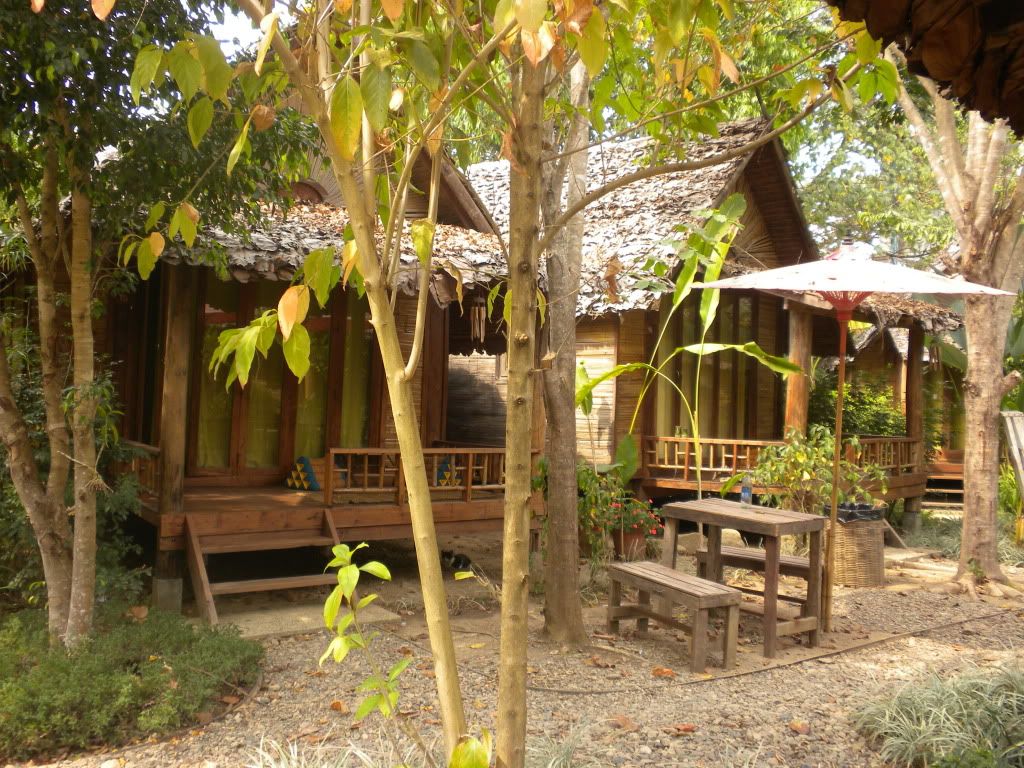
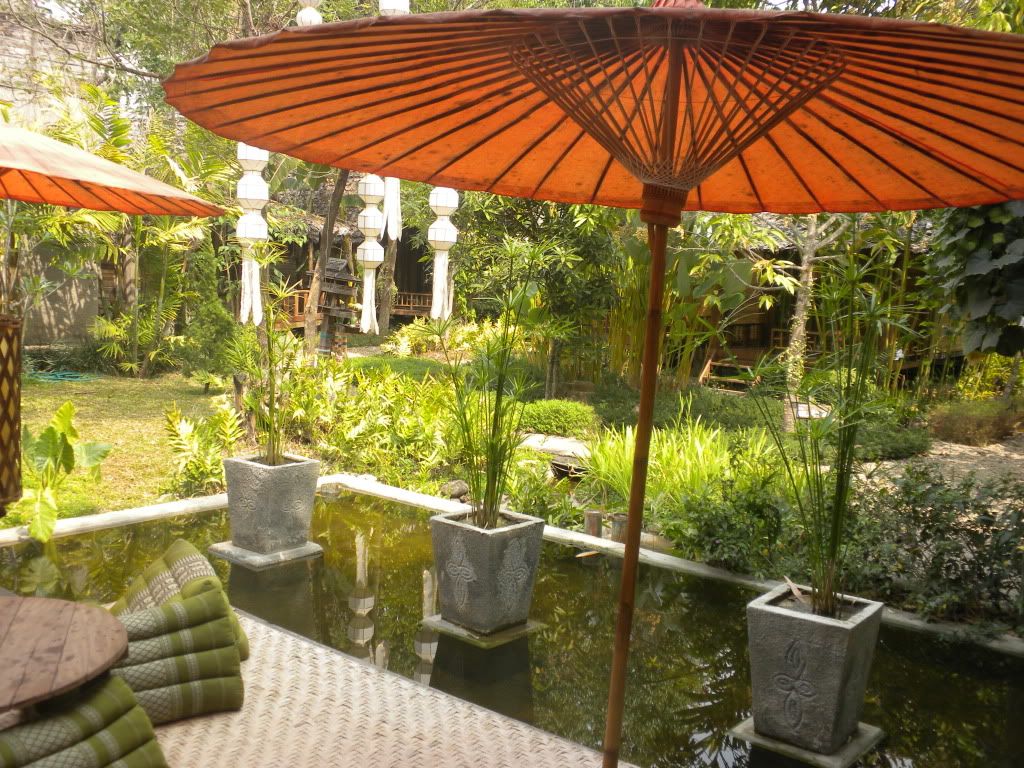
Francesca and I had heard some mixed reviews about Pai. Some had told us it was a must-see, others shared it was nothing special. We had just gone to Pai a day early to catch the bus to Soppong the next morning, so this had left us with a half-day in Pai. We picked up a little map and started walking. Pai is a bit of a hippy village, which attracted a lot of talented artists, but also its share of tourists. The streets were literally packed with shops and guest houses. Nonetheless, the feel was still genuine and the shops more unique than anything else in Thailand. We found a cool t-shirt shop, and were tempted to buy one or two. We checked out several little markets, as well as the Ting Tong, an open air club that advertised all through town with signs asking ‘Are you Ting Tong?’ along with a large mirror.
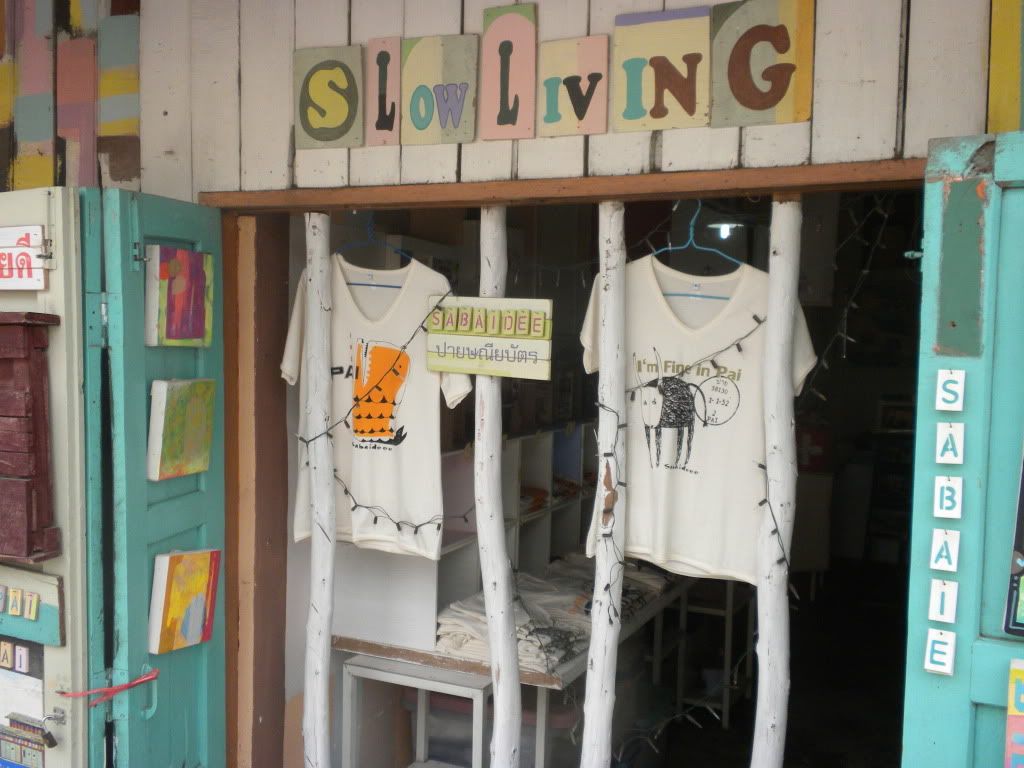
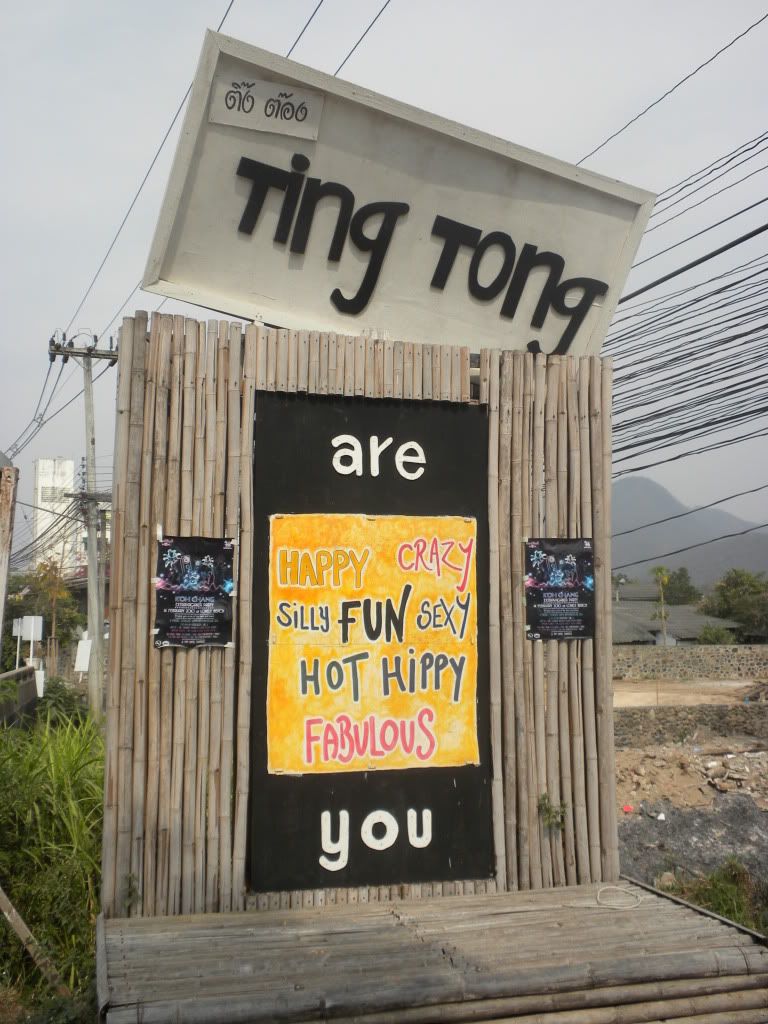
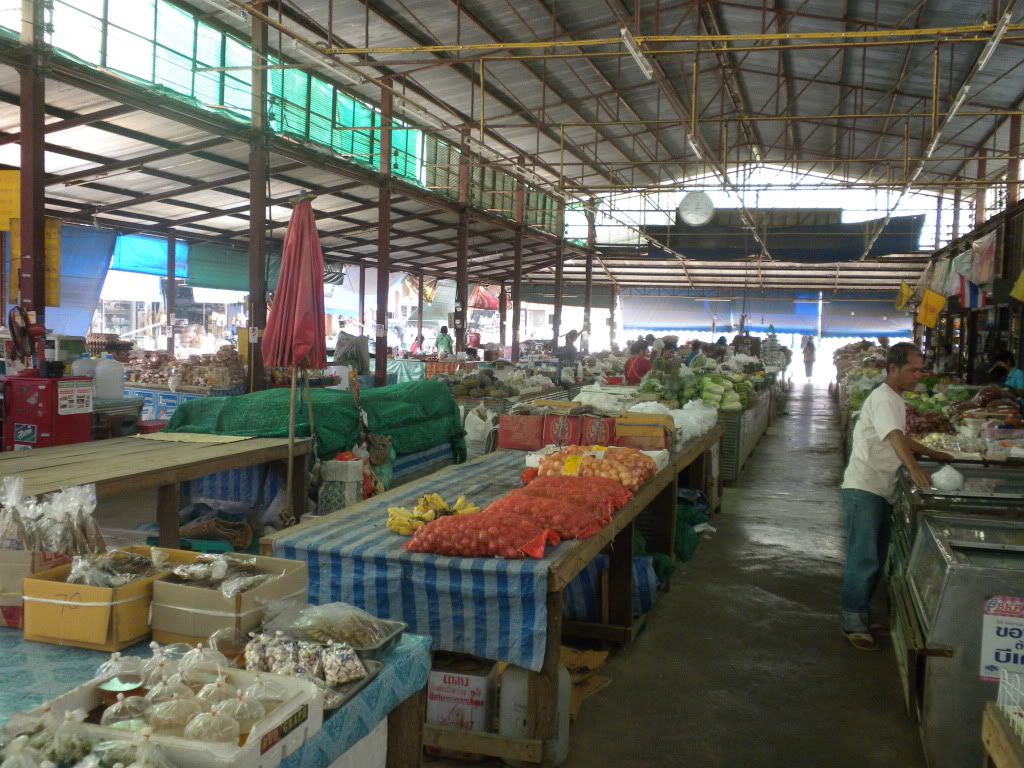
We also found what appeared to be the only sizeable Wat in town. Signposting lacked, and neither the Chedi, nor the Wat itself were too impressive. More hilarious was the fat monk that strolled around the courtyard, smoking a cigarette. Contradictio in terminis: I wonder what Buddha would have to say about that! It took us the whole afternoon to walk through all of Pai, snacking on some fresh strawberries along the way. It was no surprise we were quite hungry around 5:00 PM, so we sat down for dinner in a nice little restaurant right next to our hotel. Francesca ordered a home-made salami pizza. I was a little hungry and ordered the Tom Yam chicken (spicy soup) and a tuna salad. Francesca’s pizza looked really good, making her a happy girl. I feasted on my double dinner as well. We finally returned to our room around 6:45 PM.
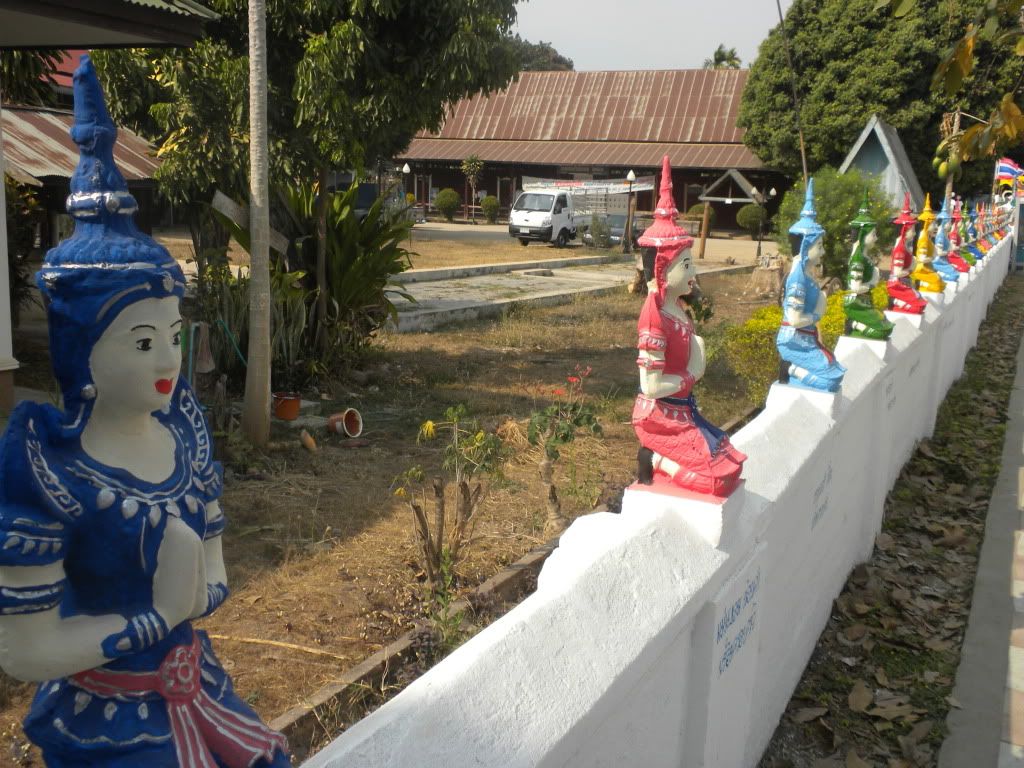
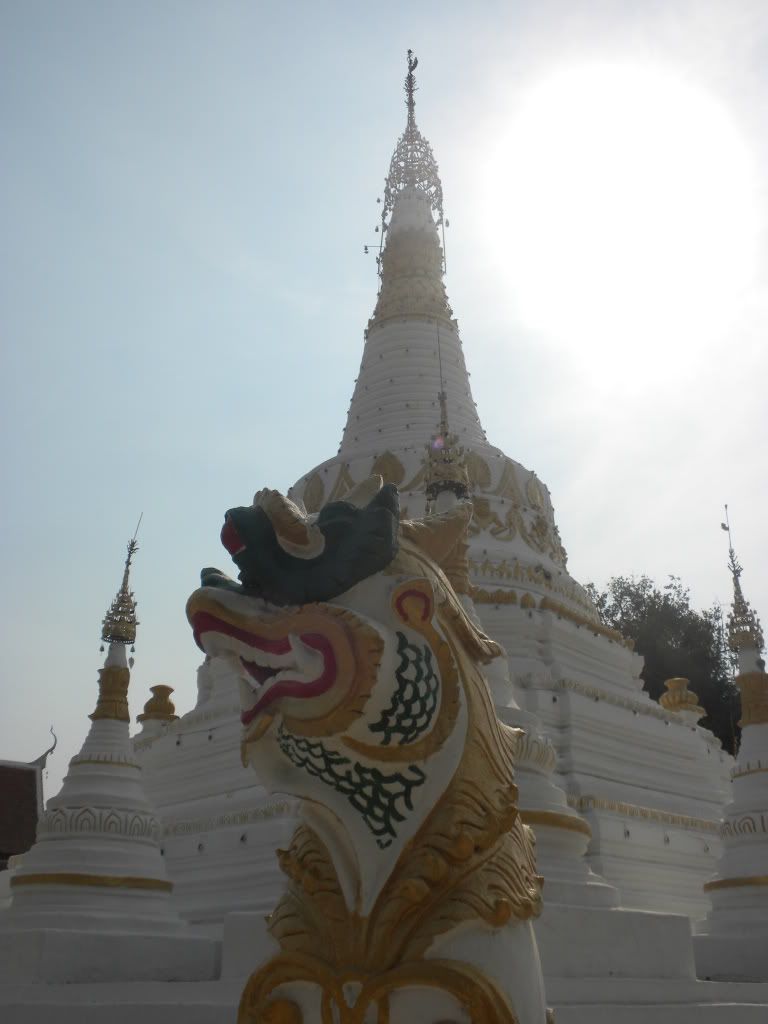
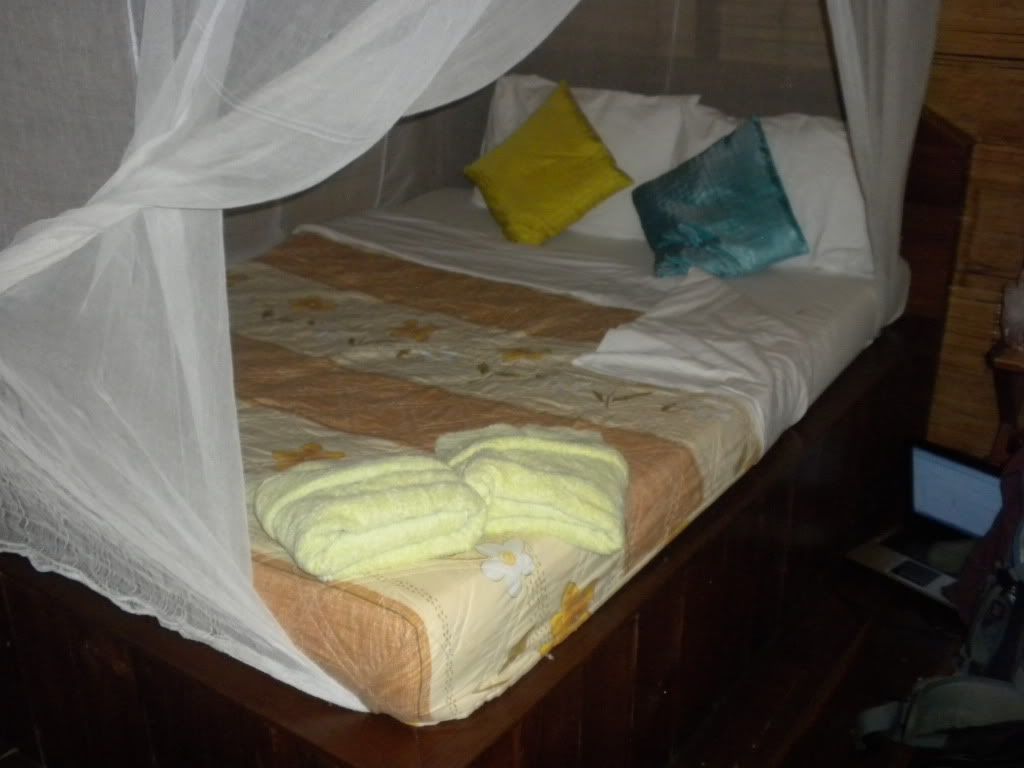
The next morning we grabbed our bags for the earliest bus to Soppong we knew about. A public bus left around 8:00 AM, and we made sure we were on it. Another hour of windy roads, combined with bad, loose seats made for an unpleasant drive. The scenery was again quite stunning, making the trip bearable. We got to Soppong around 9:30 AM. It looked like we had arrived in ‘real’ Thailand. Women were walking around, shopping for vegetables, in their traditional clothing. The one-street town was covered in dust, only had a few small stores and a handful of guest houses. We had to call Albert through a payphone and he said he was on his way. 15 minutes later a hippy old man in baggy purple pants pulled up, looking around for the 2 only tourists in Soppong. We were easily spotted and introduced ourselves. Albert ordered a motorbike taxi for me, and Francesca jumped on the back of his bike. 5 minutes later we arrived at the Lisu village of Nong Tong, after a short uphill drive.
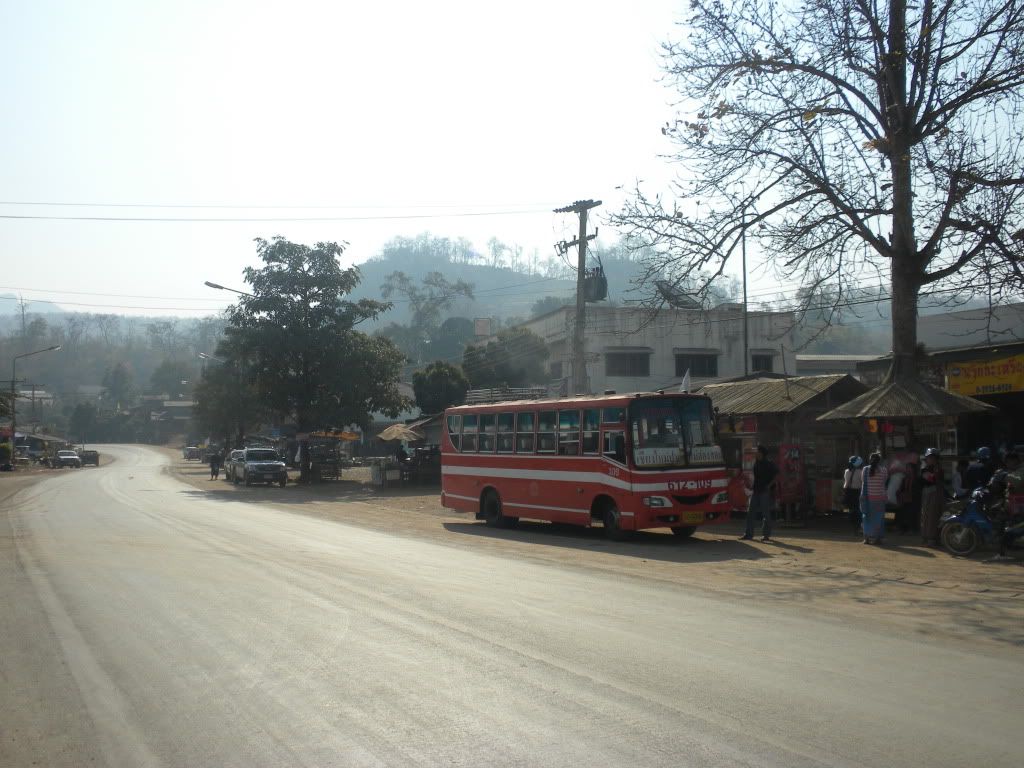
Albert showed us our room, which had a few mattresses on the floor and would do perfectly fine for the following days. He then proceeded to show us around. There was a little old school toilet outside. Albert and Susanan had one gigantic pig, which had sadly lost his brother the other week to New Year’s celebrations. Albert had built 2 little stone huts, one for himself and his wife and one for his jewelry making class. Their garden was covered in building materials, a result from the work done on Susanan’s daughter’s and husband’s new house. Albert and Susanan’s 2-storey teak house was basic enough. The first floor was a communal room, used for meetings, and the second floor was dedicated to the guests (2 rooms) and the detox program Albert runs.
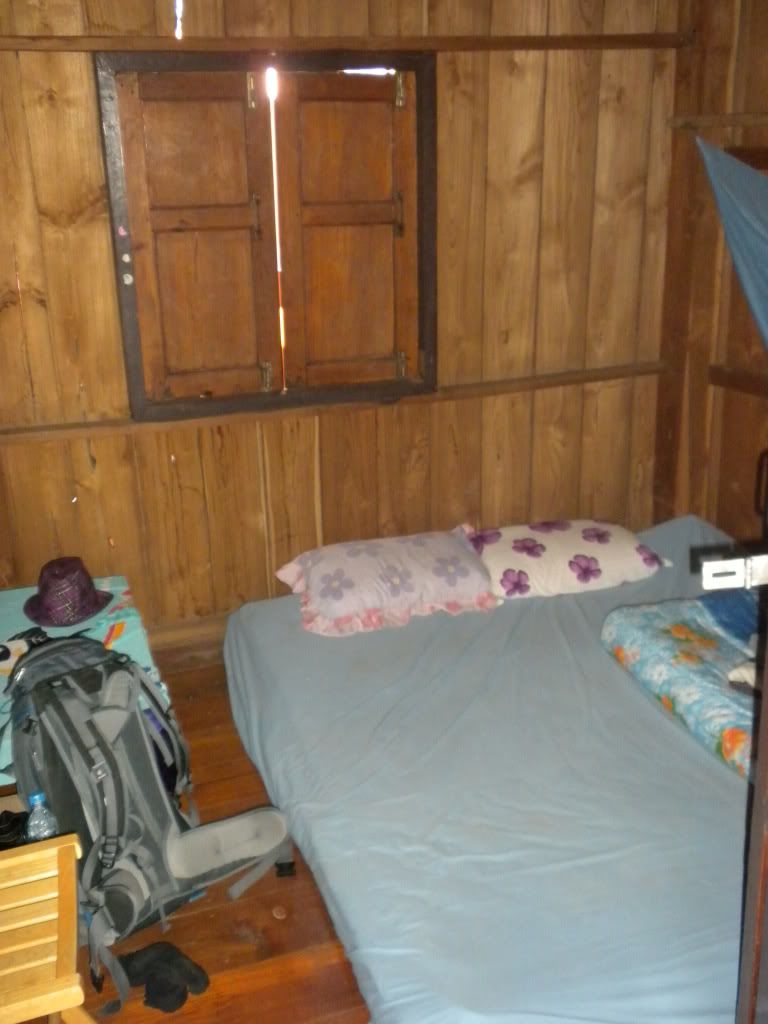
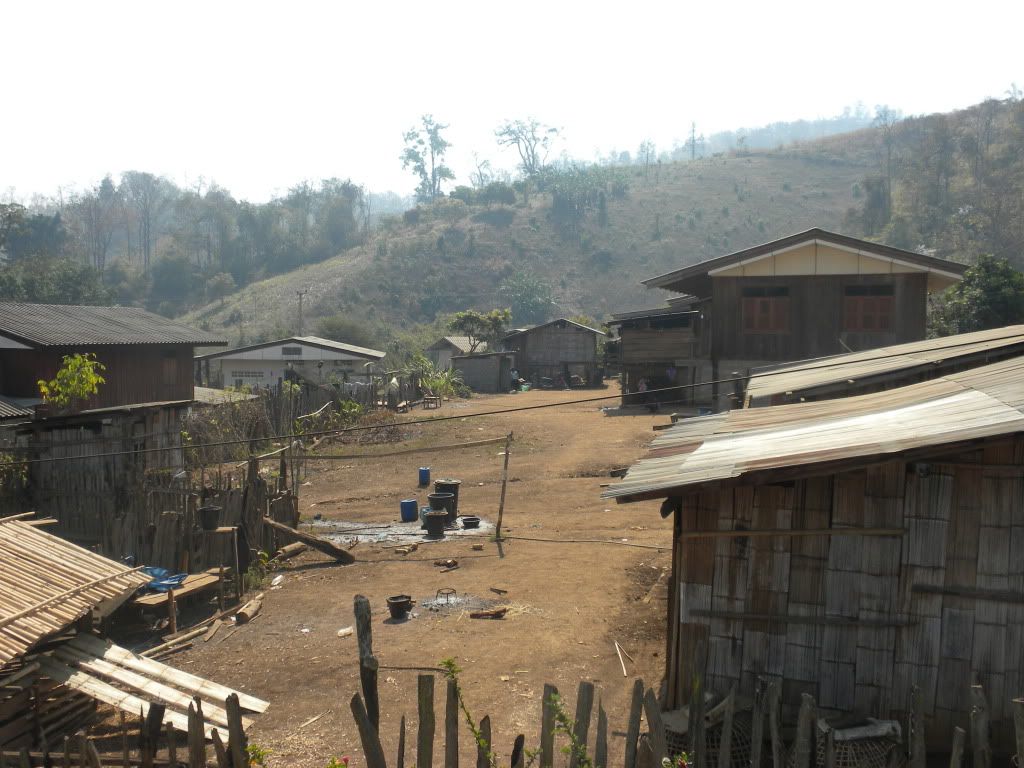
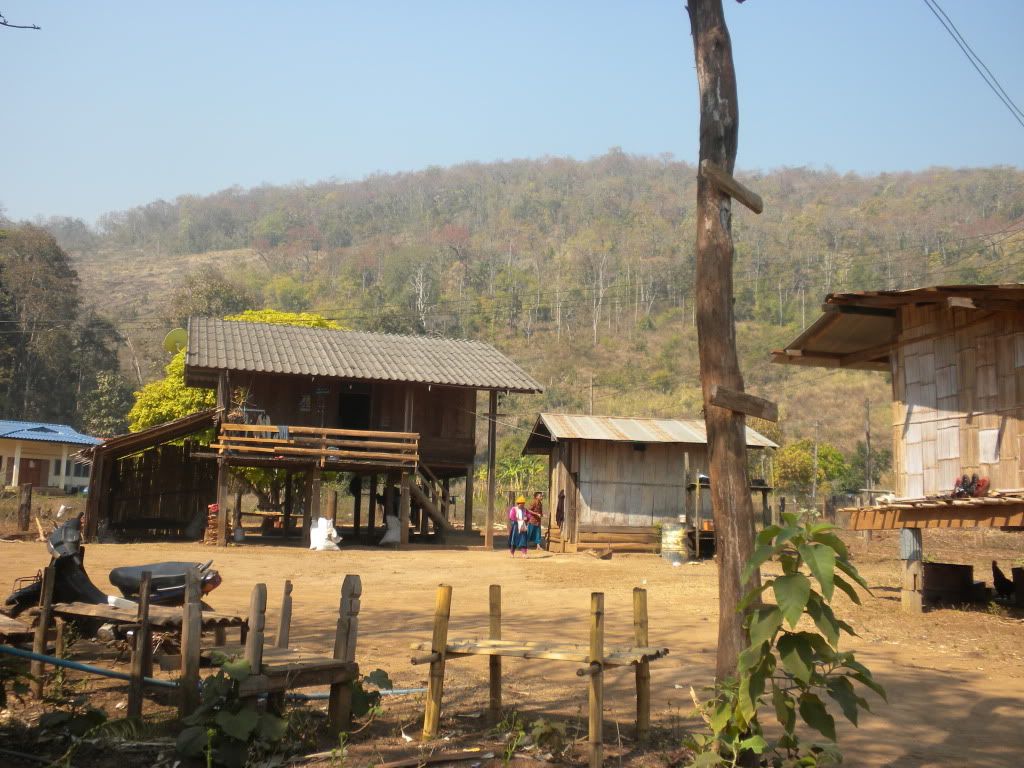
We sat down with Albert and talked to him for a while. He had been a psychologist back in the States, but had fled because G.W. Bush had been re-elected. He had opted to go travel for a year, but fell in love with Susanan when visiting a friend in Pai. He never left, getting married only months after arriving in Pai. We told him our story and he left us to explore the village on our own. The village was home to about 600 people, being a large village for Hill Tribe standards. The houses varied from nice-looking teak ones to more traditional bamboo ones. The traditional clothing was hanging outside several houses. Women were sitting, talking away, staring at us as we walked by. We found offerings to ancestors along the roadside with clothing and other amenities, as well as wooden altars with fake money. We climbed up the hill a little more, and overlooked the valley which held the little village in its mighty stone grip. Francesca posed for me on what we hope wasn’t a sacred bamboo bench.
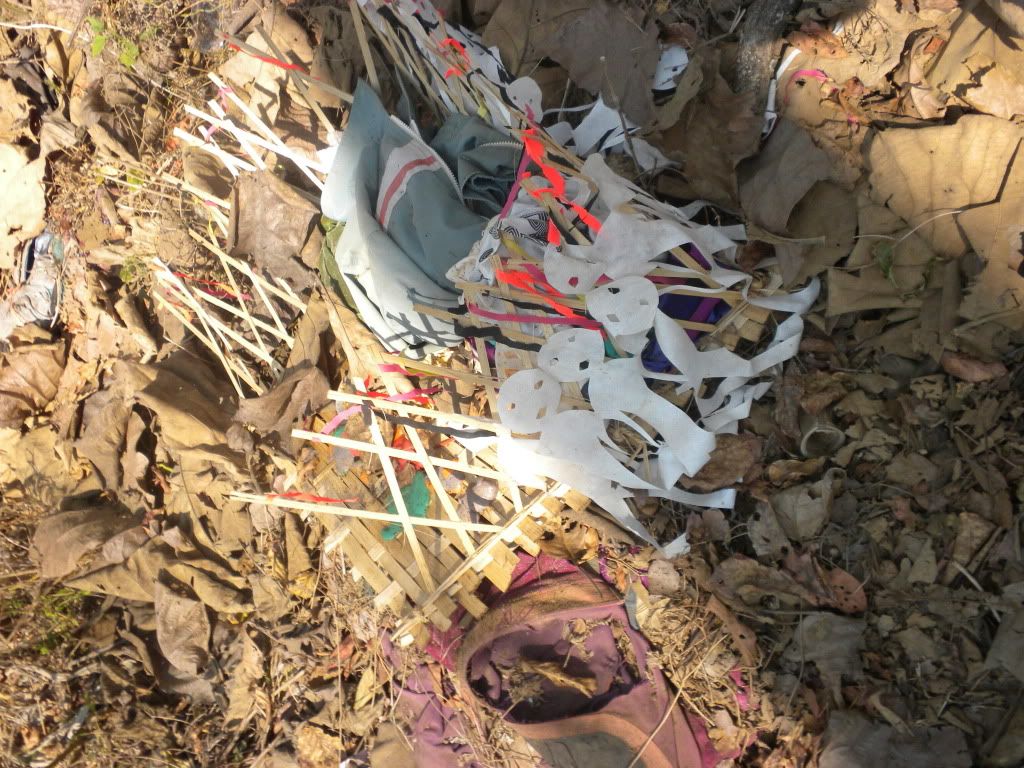
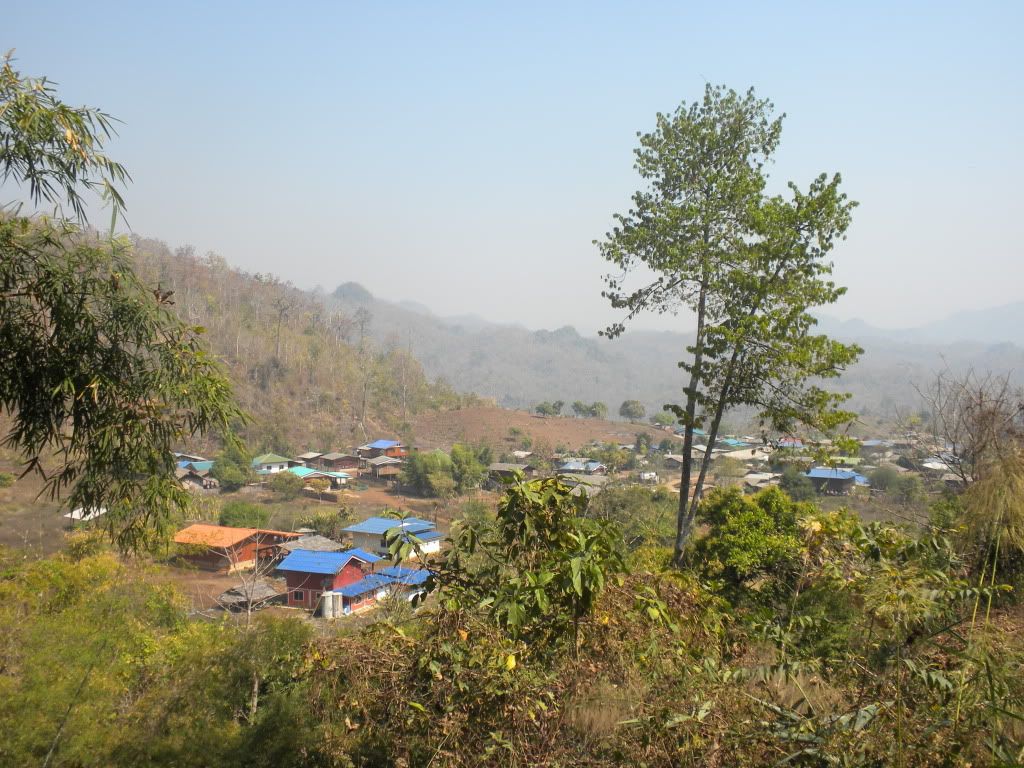
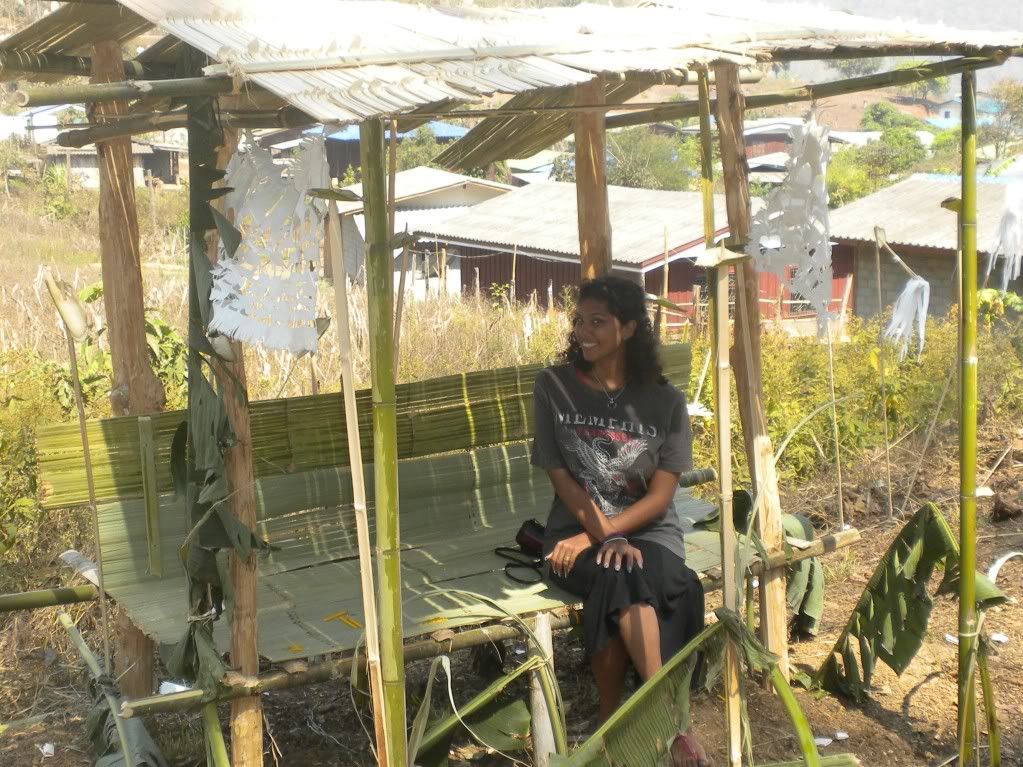
We returned from our walk and soon met Susanan as well. She was born in the village, had been married once before, and already had grandchildren. She knew a lot about edible and medicinal herbs found in the forest, and was great with a sewing machine. On top of that she was a great cook. Francesca and I sat down at noon for our fist Lisu meal. We got a plate of rice and a large tray with several dishes. Stir-fried vegetables with chicken, a potato-soup and other tasty dishes sent our taste buds straight back to Borneo and the Bidayuh.
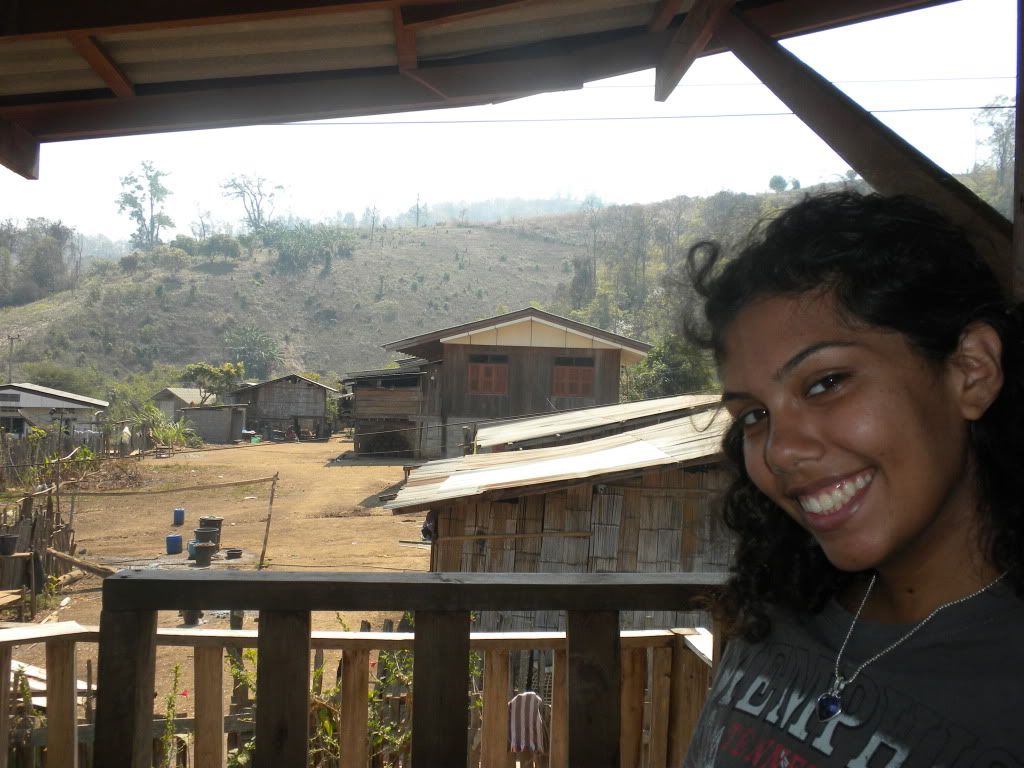
To tell you a little more about the Lisu from Sawadee.com:
“The Lisu probably originated in Eastern Tibet but came to Thailand from Yunnan in China about 100 years ago. Their settlements are located in the highlands at an average altitude of about 1,000 metres. Like most hill people, the Lisu are heavily engaged in agriculture. They grow rice, corn and vegetables as subsistence crops and grow opium for sale. They draw additional income from the sale of domesticated animals such as pigs and cattle.
The Lisu tribe is made up of several clans. The clan is important because it stands as the chief determinant of kinship relations and marriage rules. Monogamy and clan exogamy are the ideal practices which, when followed, strengthen familial ties and provide a cohesive force in Lisu society. Kinship relations are centered on the family and extended in increasingly wider circles to the tribe as a whole. Lisu solidarity, despite the lack of a political secular leader at village level, depends on this in a way that differentiates them from other tribes.
Culturally speaking, the Lisu have adopted much which is Chinese. For example, they celebrate their New Year on the same day as the Chinese. They are animists and ancestors worshipers and their reputation as individualists makes them quite distinct.
The women wear brightly colored costumes, consisting of a blue or green party-colored knee length tunic, split up the sides to the waist, with a wide black belt and blue or green pants. Long hair is tied at the back. Sleeves, shoulders and cuffs are heavily embroidered with narrow, horizontal bands of blue, red and yellow. At New Year festival, in mid- January, dazzling displays of wealth are worn, including waistcoats and belts of intricately fashioned silver and hats with multi-colored pom-poms and streamers. Men wear green, pink or yellow baggy pants and a blue jacket opening vertically.”
In the afternoon Francesca and I decided to go down to Soppong to have a look around town and look for more things to do. We looked around the market, and got to try some strange fruit! We later found out they were sour plums. Very good! We sat down at one of the riverside guesthouses and had some water. When we were done exploring Soppong I ordered two motorbike-taxis and within 5 minutes we were back with the Lisu. Dinner was ready and served pretty much right after we got back. We joined hands with Susanan and Albert and Susanan said a little prayer. Here’s a picture of the feast that was served!
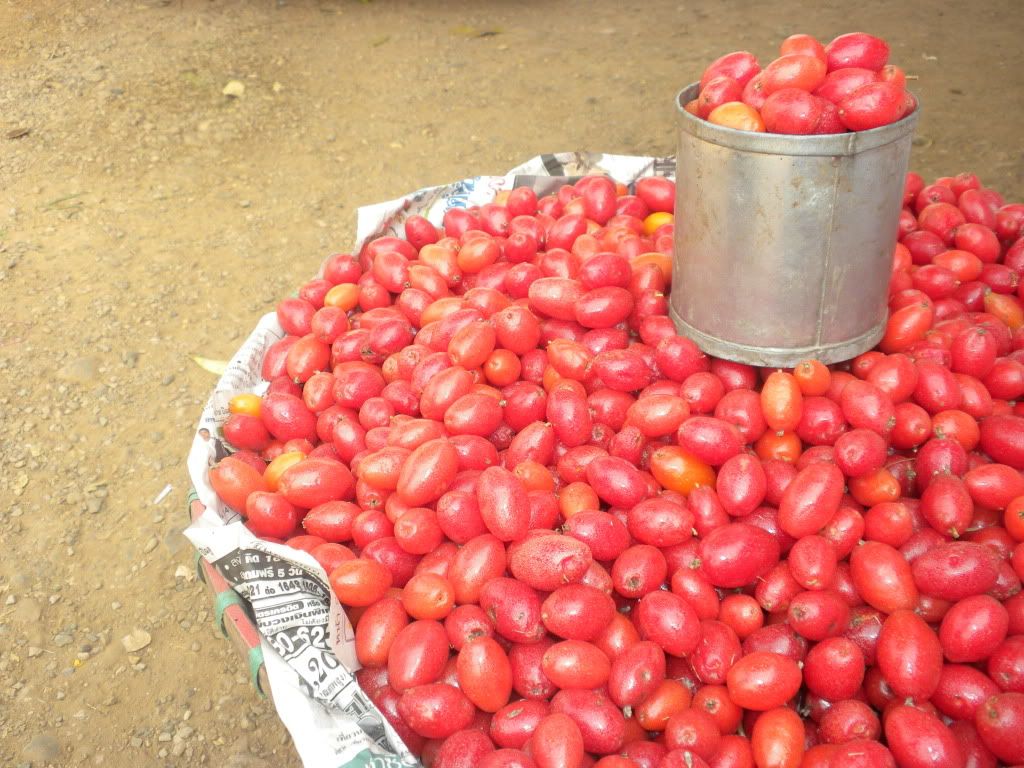
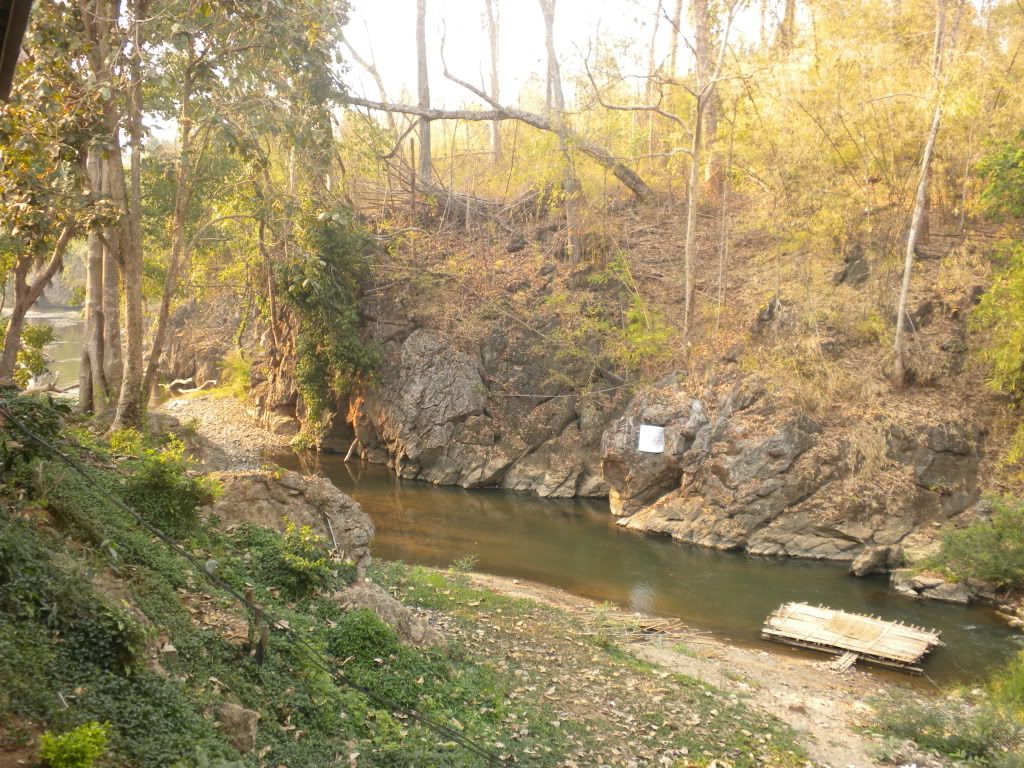
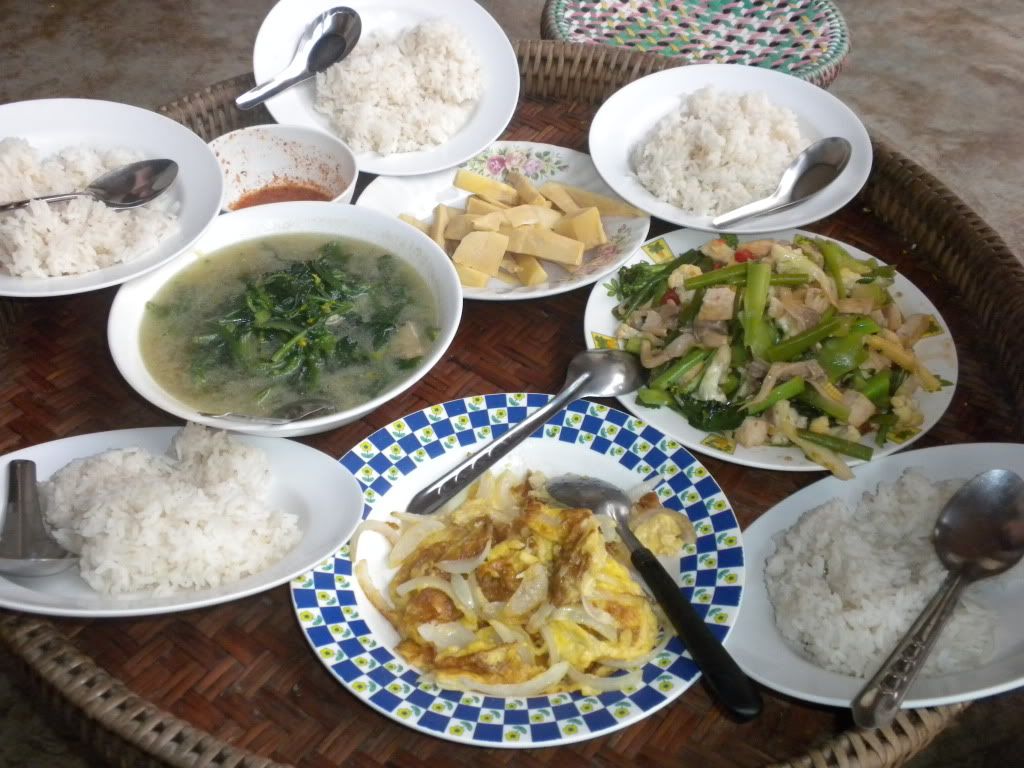
Francesca and I woke up early on the 23rd, rising to the familiar sound of crowing roosters. We had asked Albert to sign us up for a talk with the village shaman, as well as a walk through the forest to see some medicinal and edible plants. However, the shaman had backed out and Susanan didn’t feel much like walking, having to take care of her grandchild at the same time. She complained openly about Albert overworking her. After breakfast Francesca and I headed back to Soppong to talk to the only tour operator in town. His name was Toy and he was a Red Lahu. Toy had a really nice tour on offer that would take us to all the different villages from 4 different tribes in the neighborhood. He threw in a trip to the Tham Lod Caves as well. We agreed to join the trip the following day. Toy then kindly invited us to come with him to a Black Lahu New Year’s celebration that same evening. Francesca had been quite chuffed we had missed out on so many different celebrations, so this offer was very welcome to us. We agreed to be back at Toy’s office around 6:00 PM.

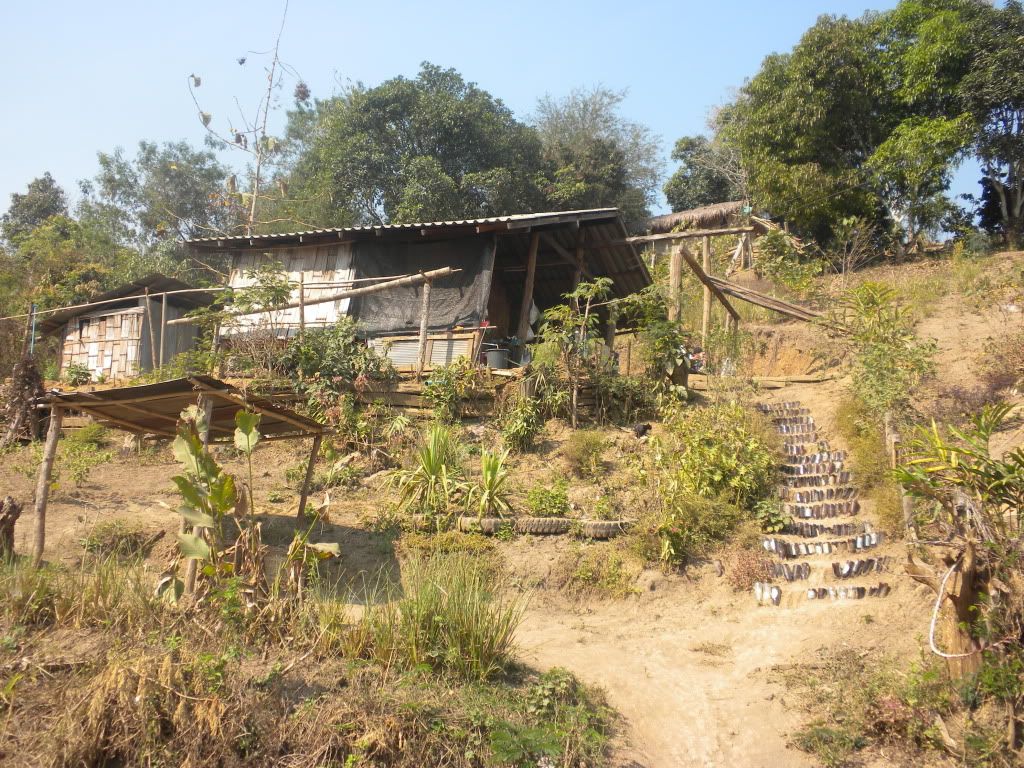
Tuesday in Soppong is also market day. The hill tribe people come down from all the surrounding villages to sell their wares. Once, they used to sell only food and handmade tools and clothing. Nowadays, the unavoidable Chinese- and Thai-made stream of crap has permeated this part of the country too. Still, seeing the kids and mothers walking around in their traditional clothing made the whole experience more real. It had been a little cold in the mornings in Pai and Nong Tong, and when Francesca spotted a cute purple hoodie for a few dollars, we ended up buying it.
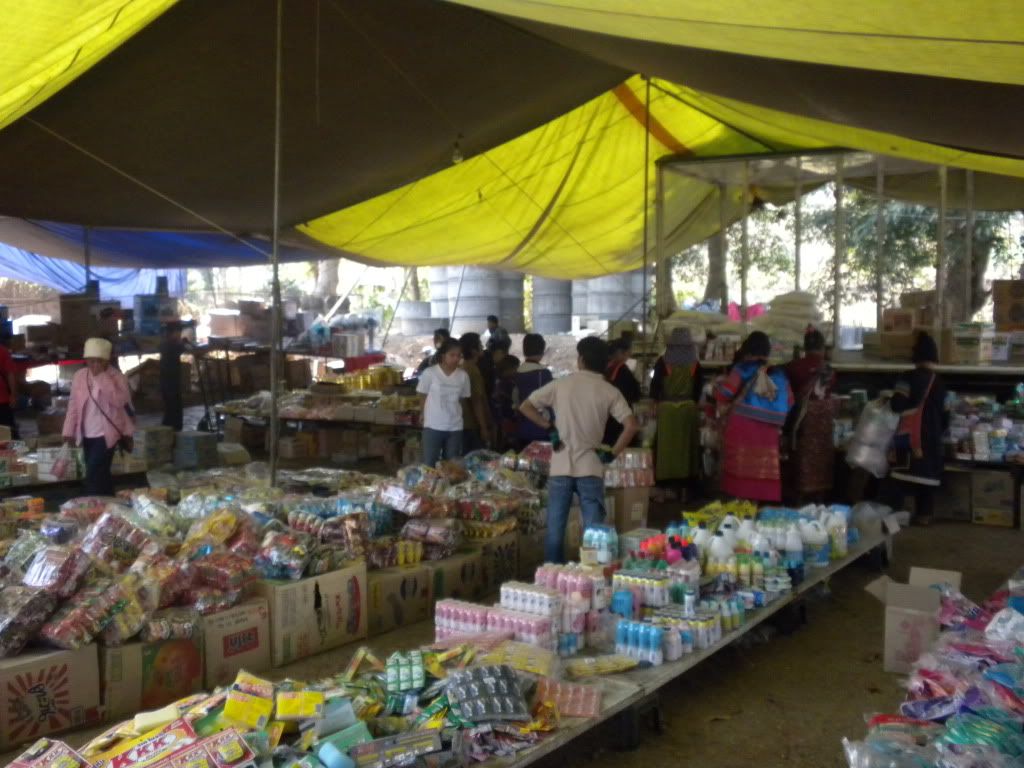
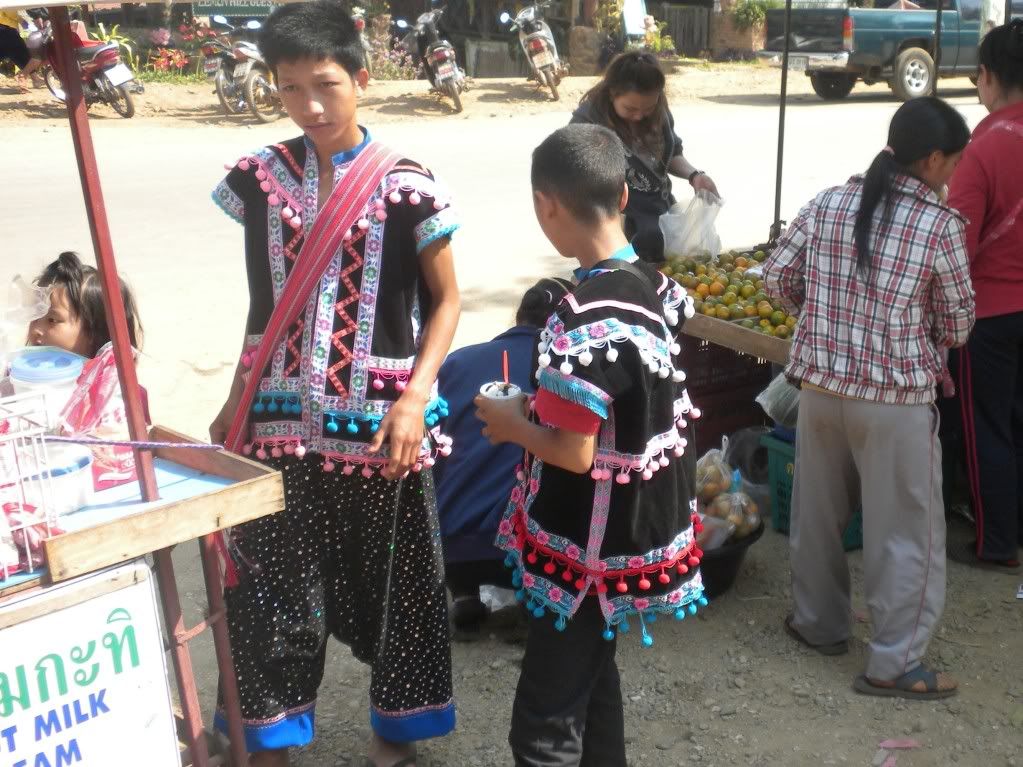
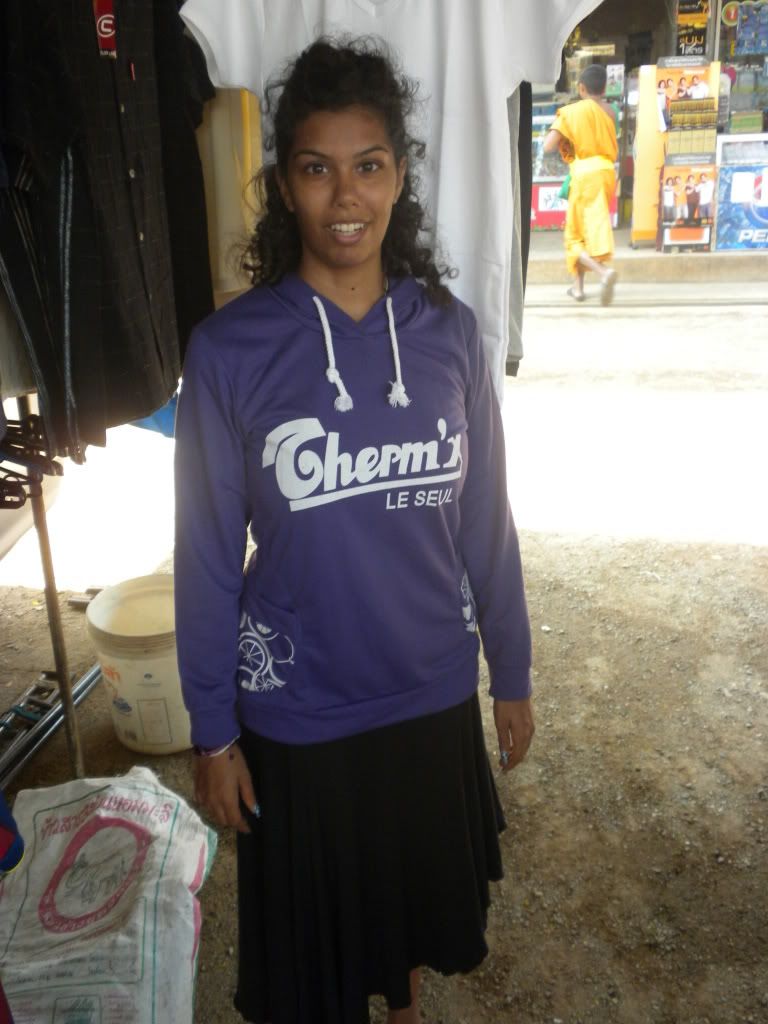
On our way back up, walking this time, we heard music and saw people dancing. We couldn’t contain our curiosity and walked over to the courtyard where the festivities were taking place. Susanan was there too and she told us the Yellow Lahu had come to celebrate New Year’s here. We carefully examined the dancing, which looked pretty simple. The headman was also looking on, eventually joining in. Some laughter erupted when an old man had finally decided to join, but the dance just ended as he started to boogie. I shot some videos of the dancing, as well as the onlookers. It’s bizarre to see the combination of traditional wear, combined with jeans, golden watches and mobile phones. I find it fascinating to see this blend of ancient customs and modern day. It seems to conflict so much, but the hill tribe people have adapted to the changing times amazingly well. Before we knew it an hour had passed, Susanan had gone and lunch would be ready by the time we’d get back.
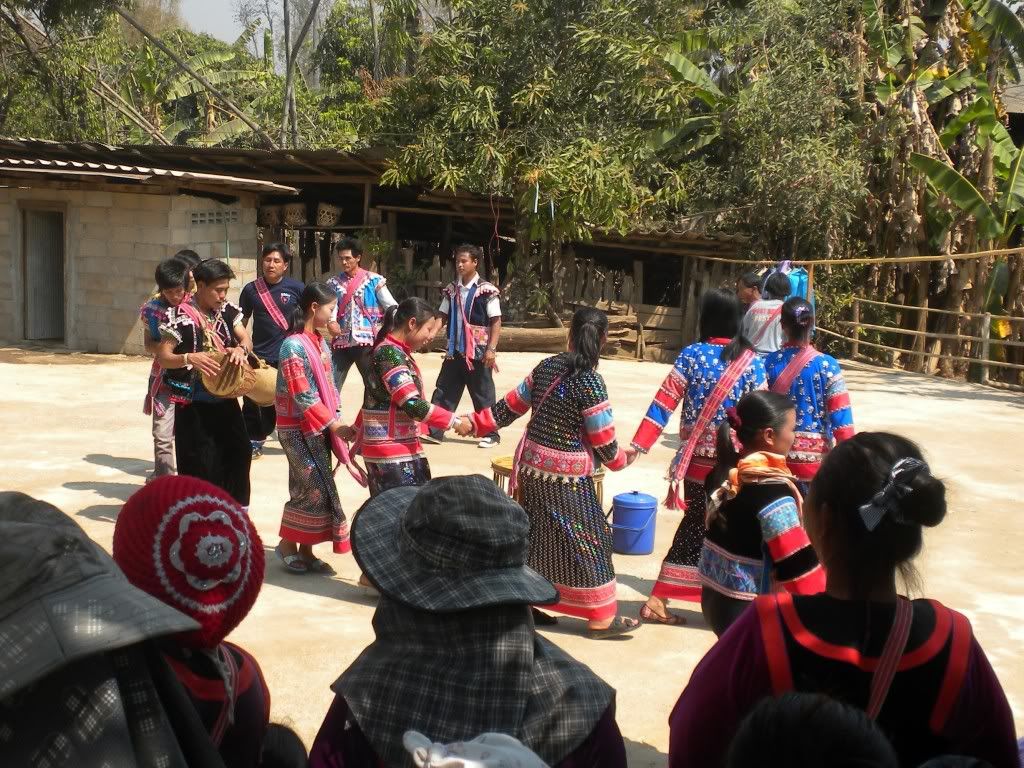


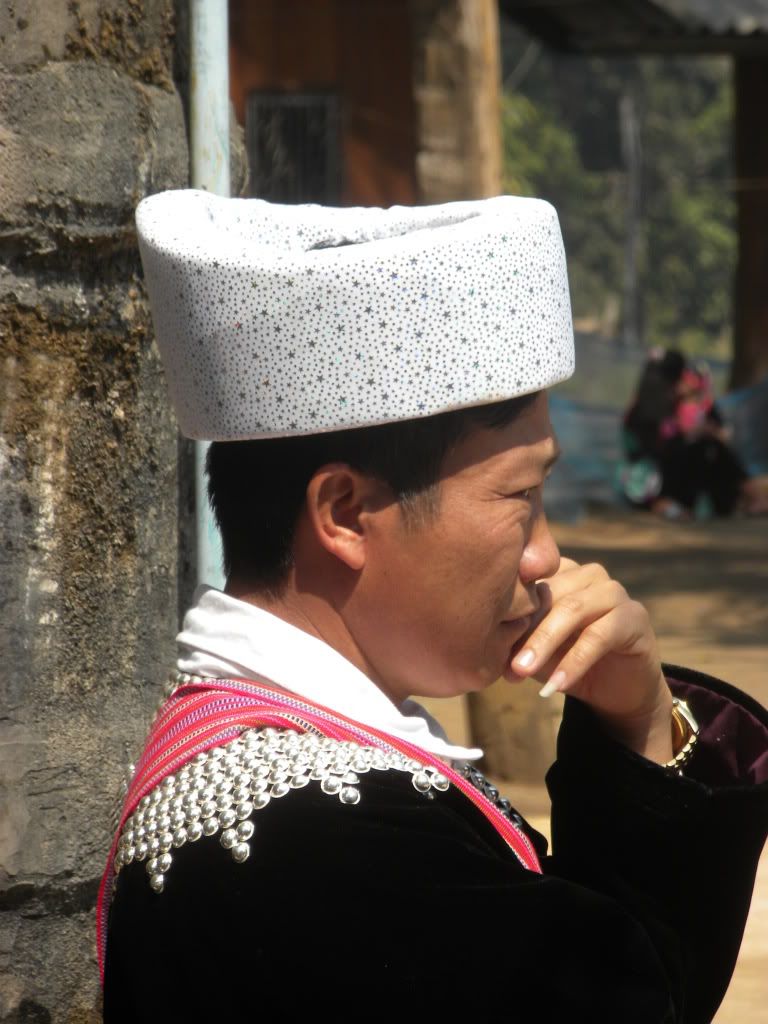
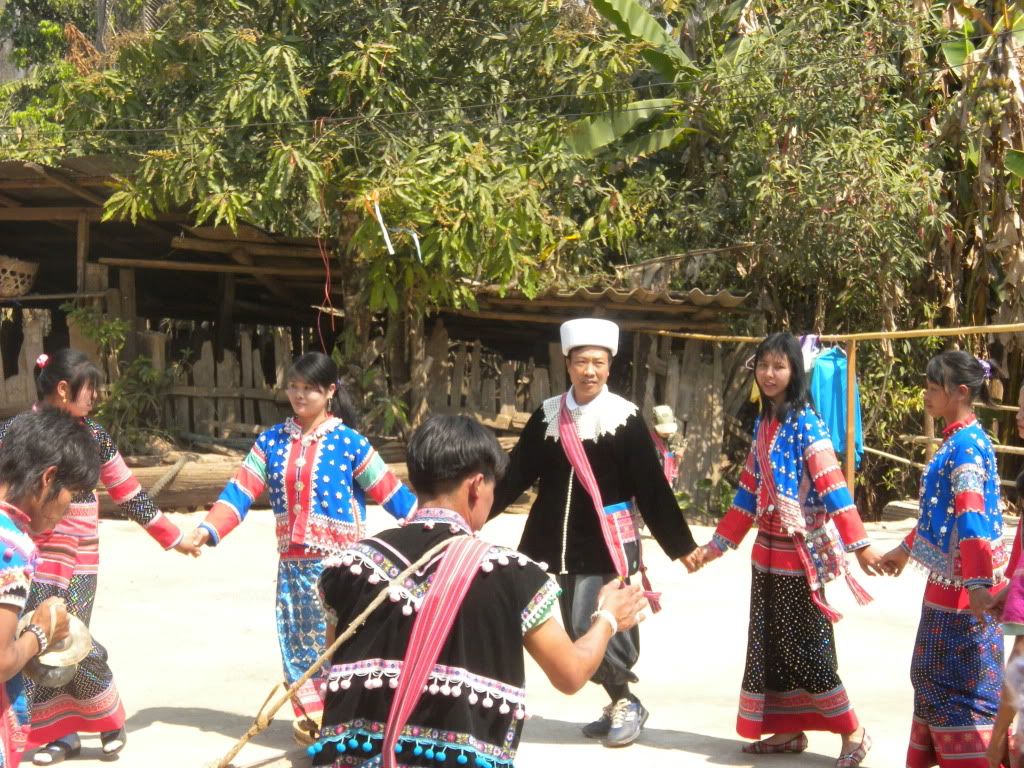
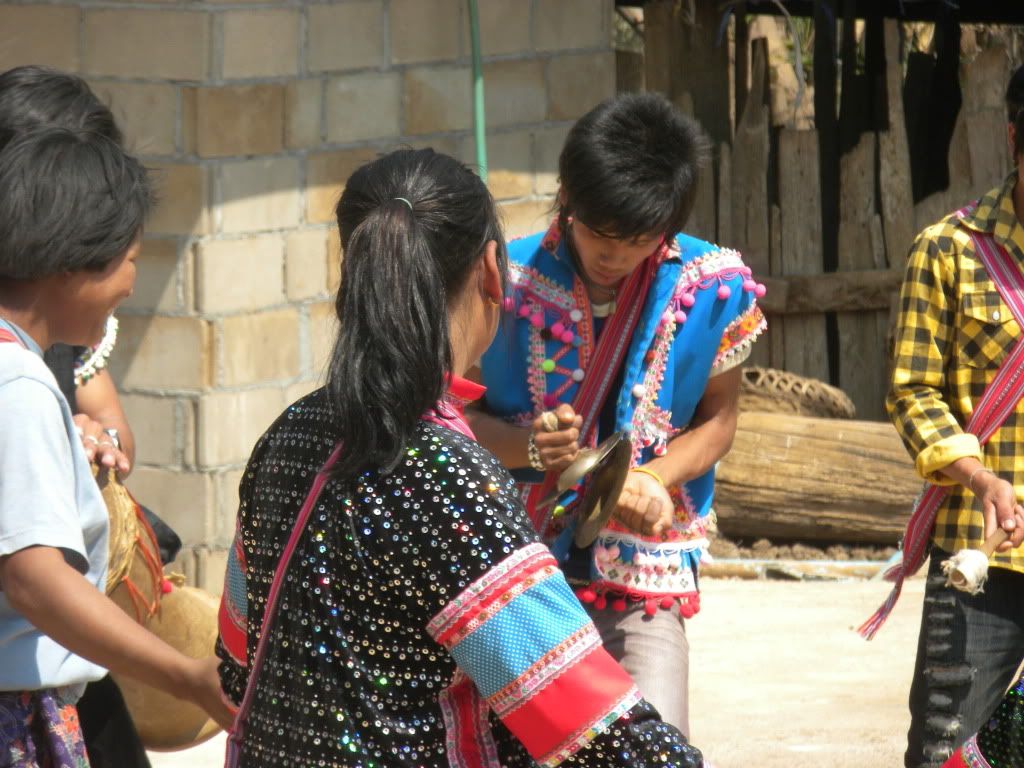
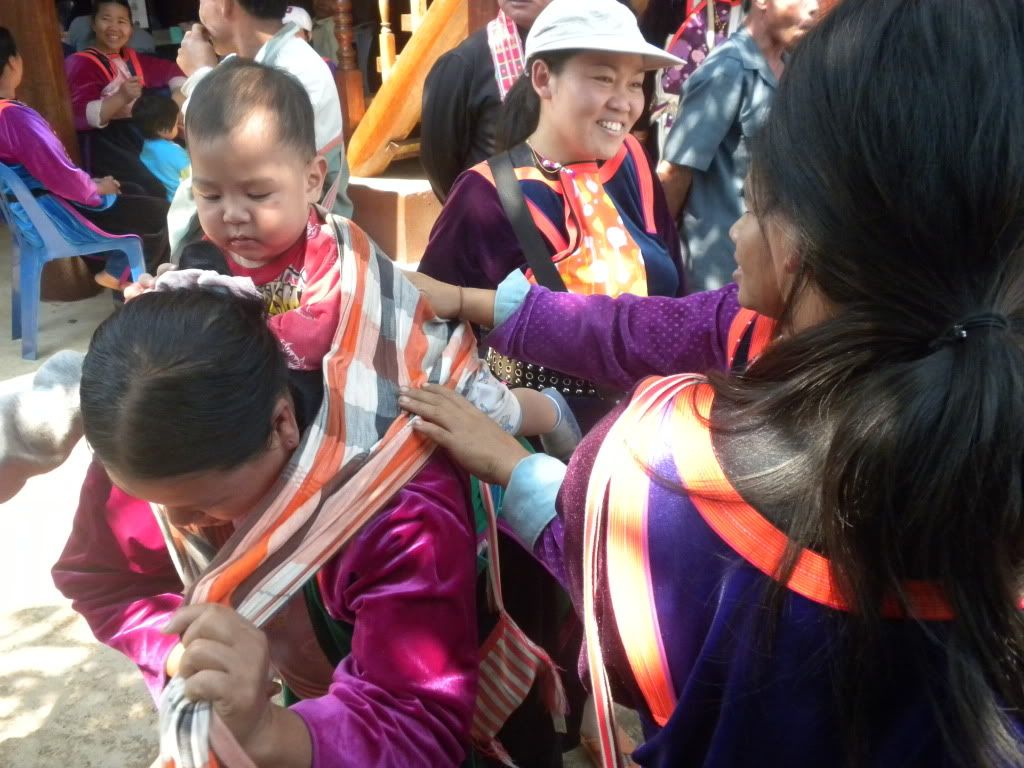
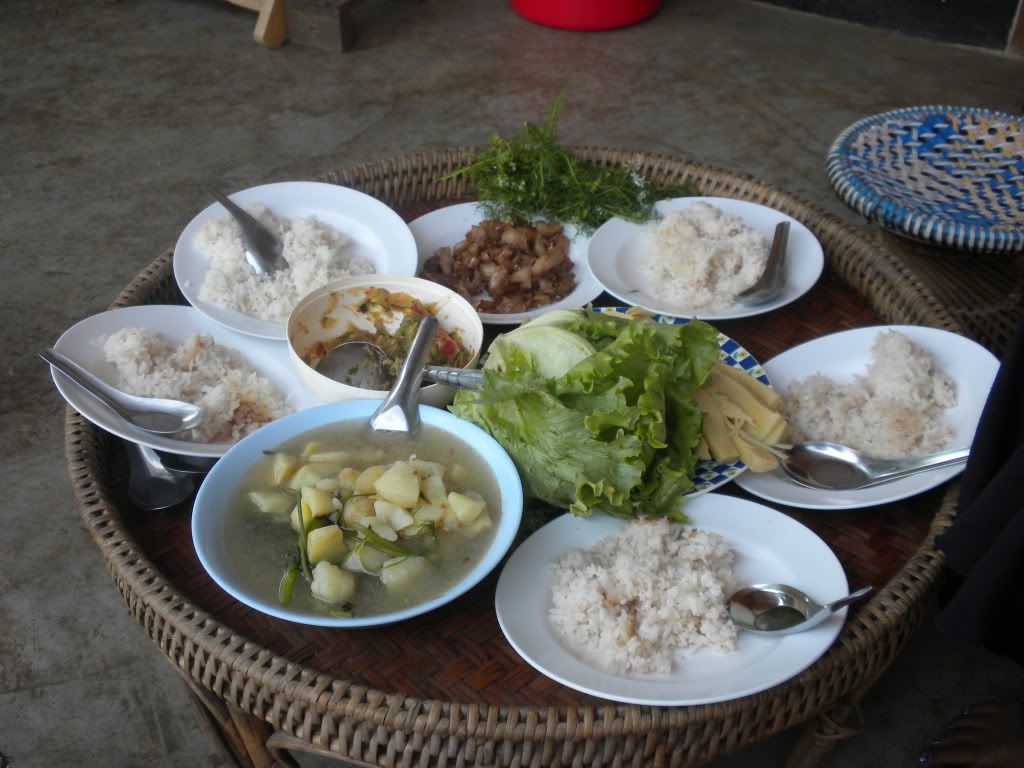
Lunch was a sumptuous tray with rice, pork, potato-broth, bamboo shoots and lettuce with a spicy salad. We sat around for the rest of the afternoon, reading the books Albert had given us on the local hill tribes. One book especially, ‘Wild Times’ by John Spies, had drawn our attention. It told the story of an Australian man that had left for the north of Thailand in his early 20s, becoming the first farang to live in the region in the late 70s. His fascinating adventures and tales of death gave us a very good idea of the hardships he had gone through, and how the locals had reacted to the arrival of foreigners.
Shortly before 6:00 PM Francesca and I went downhill and met up with Toy. Another couple joined us in the back of Toy’s pick-up, and off we drove. On the way to the village Francesca and I talked to the British couple, Wendi and James, about our travels and their travels. A good 20 minutes later we arrived at Bo Kai. Toy told us to go explore on our own, leaving us with the Black Lahu kids and their fireworks. The village was very basic, in a sense similar to Nong Tong. One difference we soon noticed was the presence of pigs all around us. The Lahu don’t have many chickens, but what they lack in poultry they make up for in pork. There were also a few water buffalos and cows grazing here and there. We made our way back down, looking at the mountains around us. Sun had set and it was getting dark quickly.
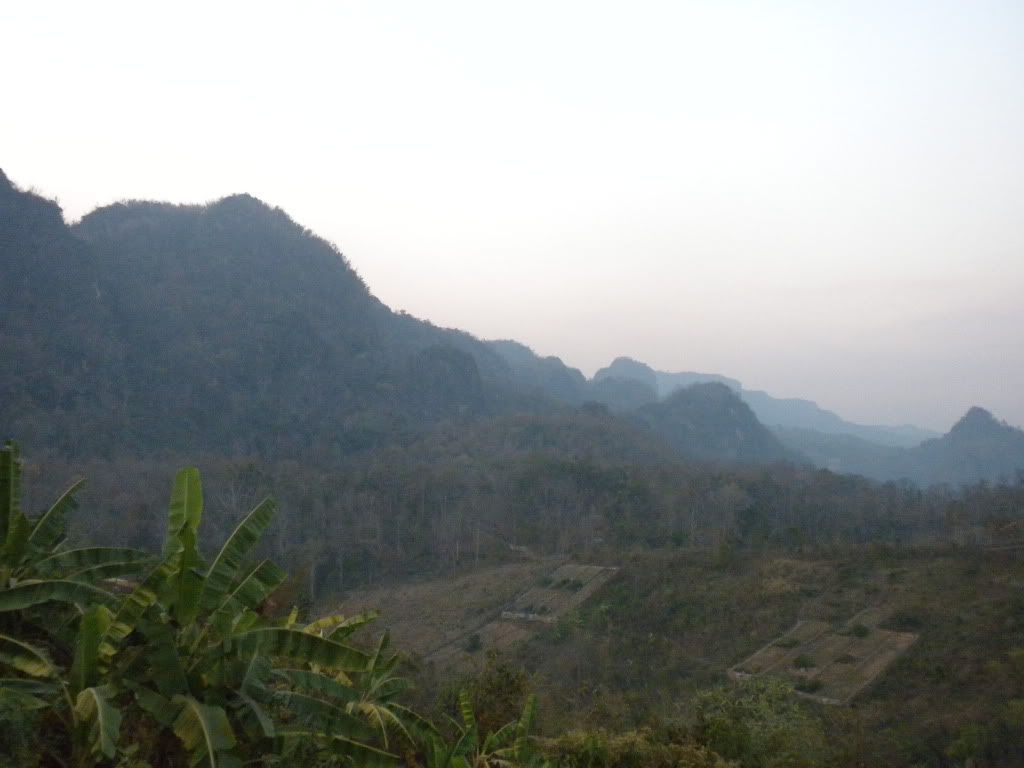

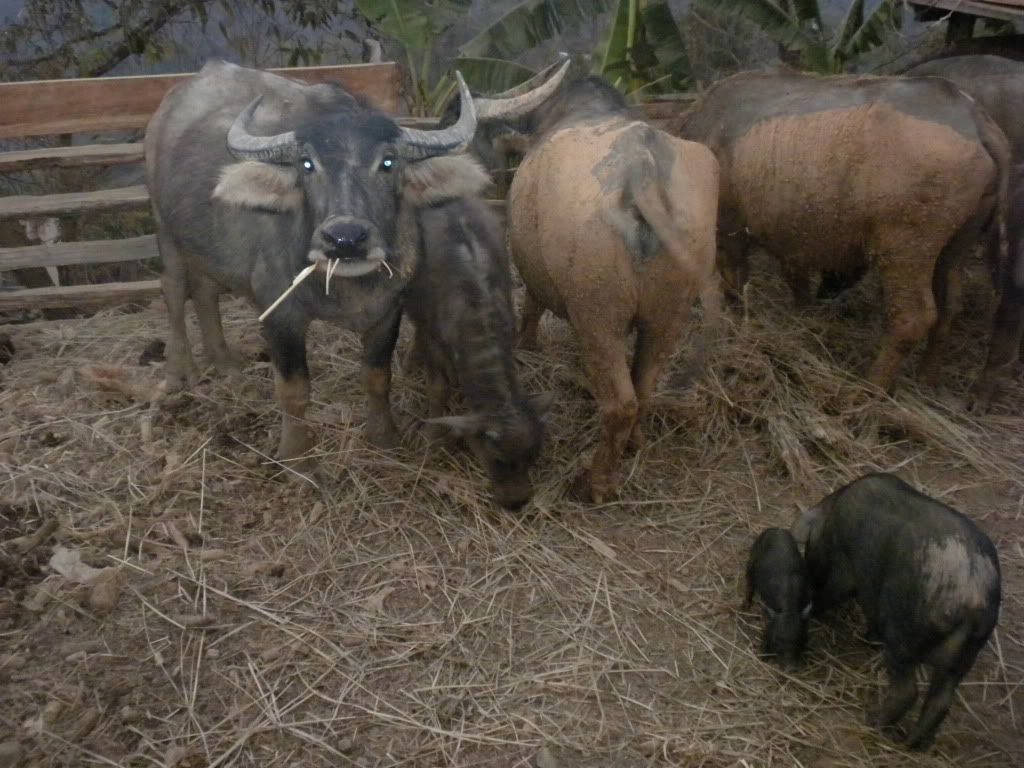
Back at the drop-off point Toy proved hard to find. Some other locals offered us tea, cooked over a fire and to be taken in by bamboo. Yes, a traditional bamboo cup. How cool! A little while later Toy was found and we were invited to join the party in the headman’s house. We sat down on the floor and were offered a sip of beer each, for good luck. We also almost immediately received a plate and got to share a pork salad, pieces of pork meat and pork fat. Better still were the lumps of rice with dough around them. Massive and heavy on the stomach, they tasted delicious in their simplicity. We felt quite welcome, even though we couldn’t really talk to any of the people.

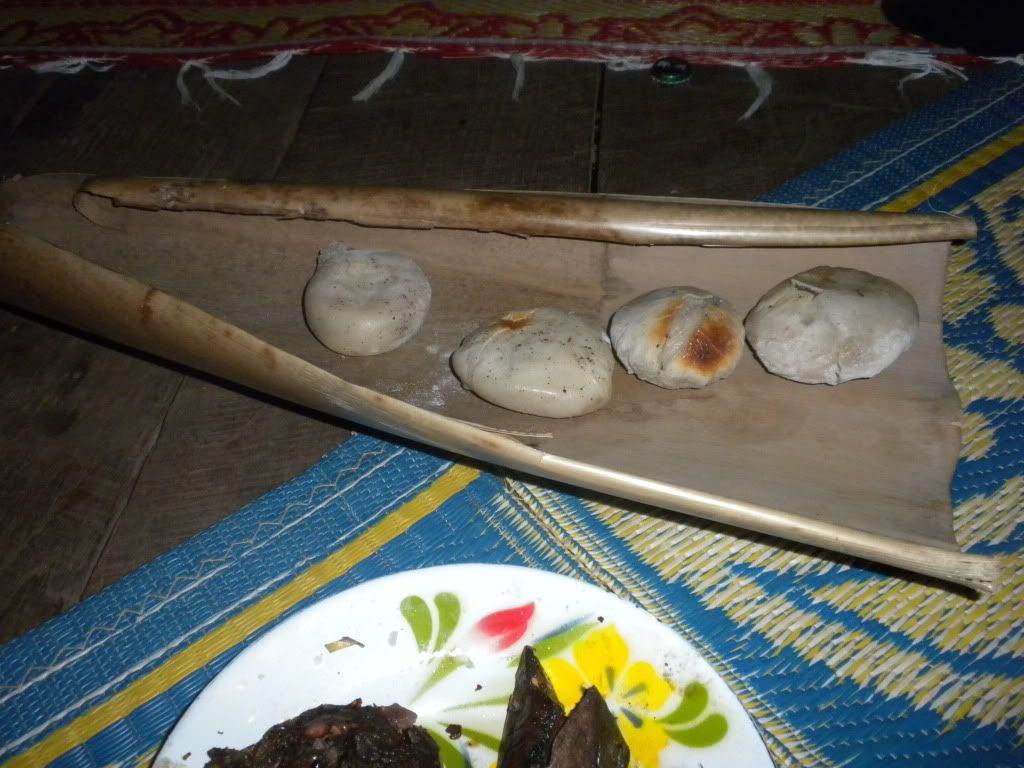

After we had our fill Toy took us to the next house. It’s customary to continue the party in house after house from the early morning to the following morning. It seemed to have gotten to the headman, who laid down in a corner and fell asleep. Toy said he’d be awake soon enough to continue partying. We doubted his statement; the man looked positively wasted. At the next house we got offered more food, as well as whisky. It was more of the same, and we were already stuffed so we declined much more chow. Again, the locals spoke little English, but when English football became the topic of conversation everyone managed to shout a favorite team. Liverpool seemed to be on top, with their Thai fans outnumbering the ManU supporters. Quite fascinating to see how the people love European football.
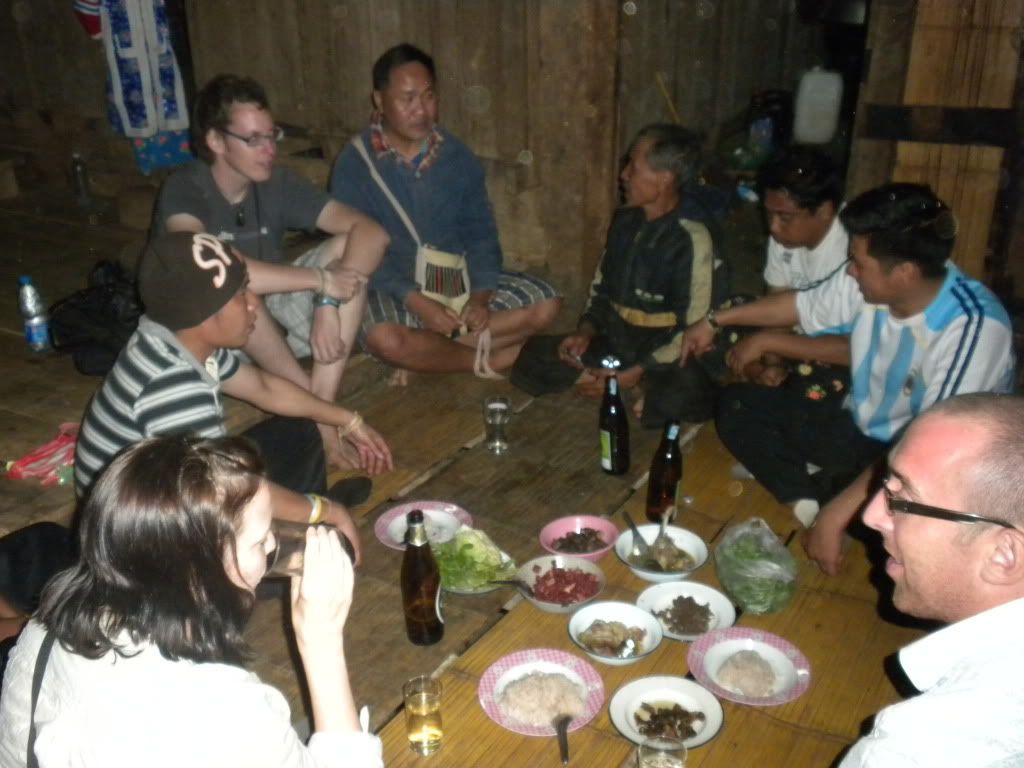
Around 9:00 PM we were sent outside with one of the local boys to go to the dancing ‘arena.’ A large tree trunk with a candle on top decorated the center of the arena, and soon some men were dancing/stamping around it. One of them had a bottle gourd flute, the rest just danced to the rhythm. I joined it for a while, partially because I was asked to and partially because I was getting pretty cold. After a while more people joined and the party got started. We heard the Lahu dance to sunrise the next morning, so it was no wonder their dancing wasn’t all too exciting. There’s a lot of holding-hands and stepping around in circles. The tempo stays low, and people are free to join in any time. We all managed to last until 11:00 PM, even though Toy had wanted us to stay much longer. He had been enjoying the free food and drinks with his family quite a bit and was reluctant to go home.

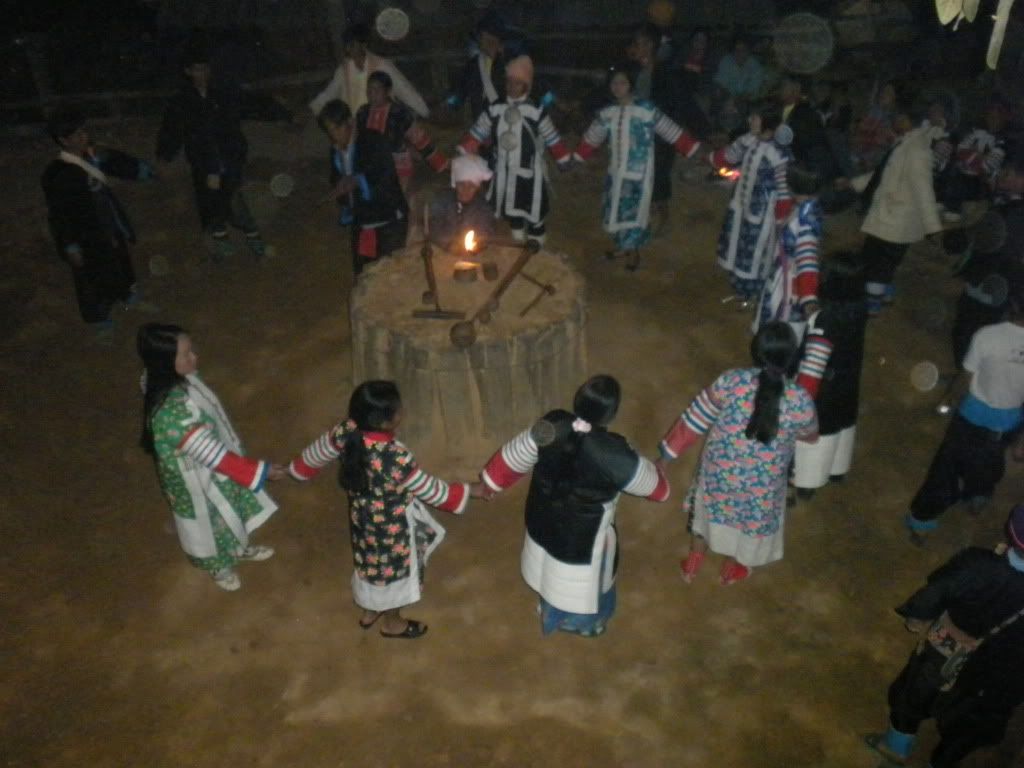
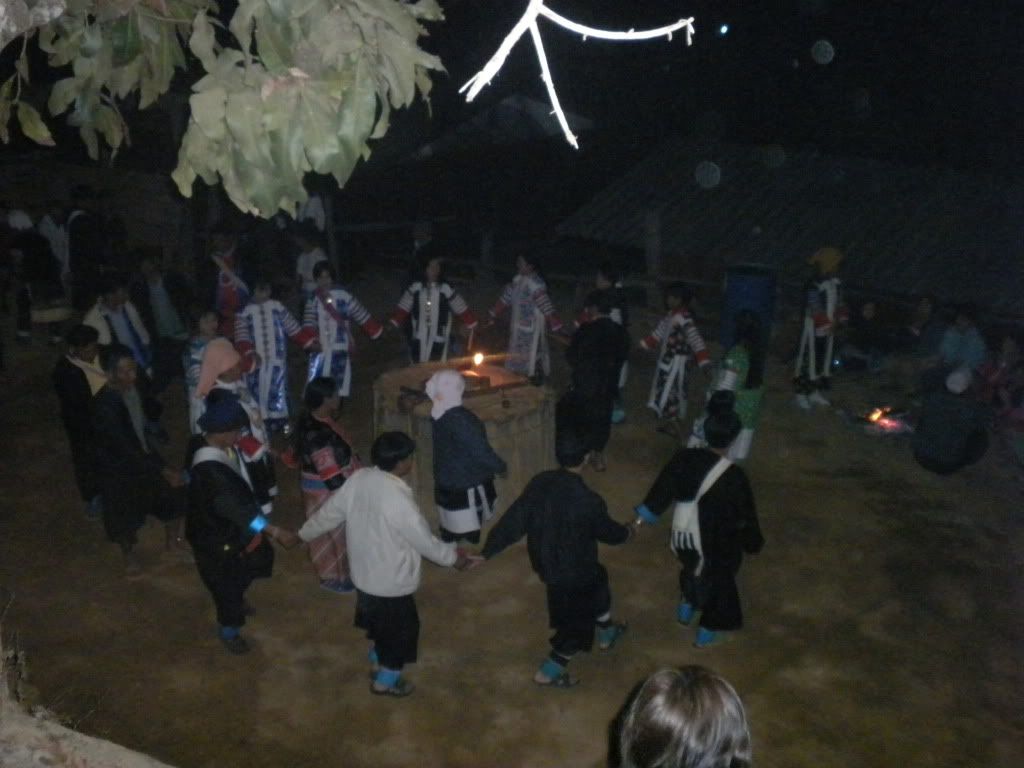
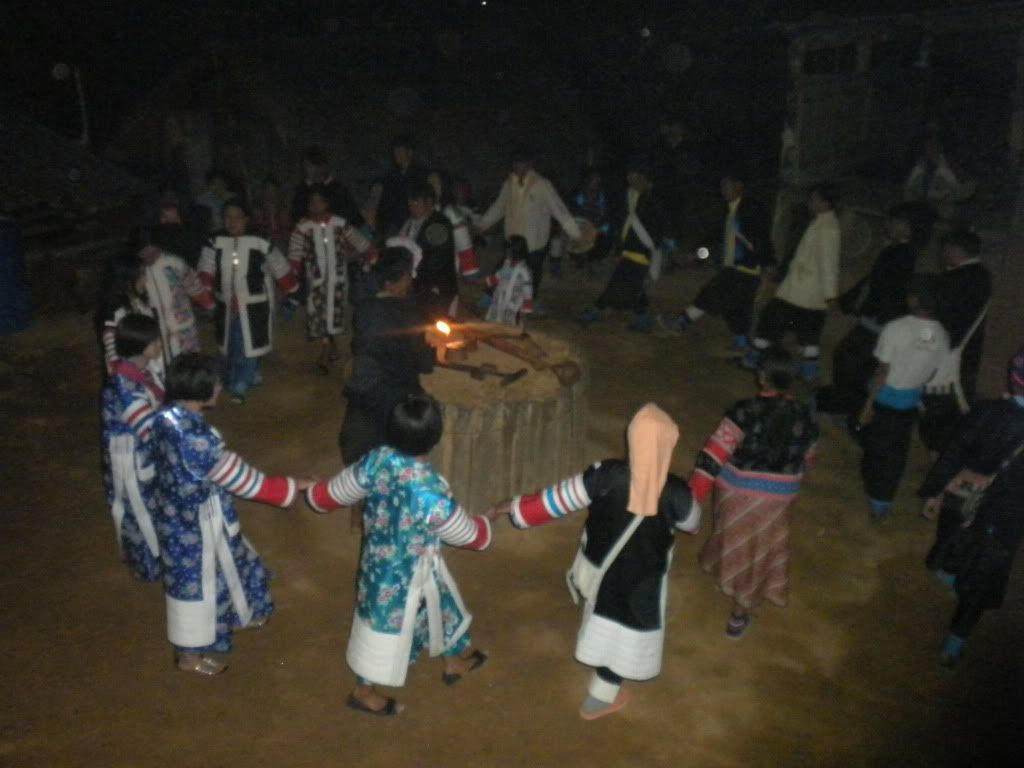
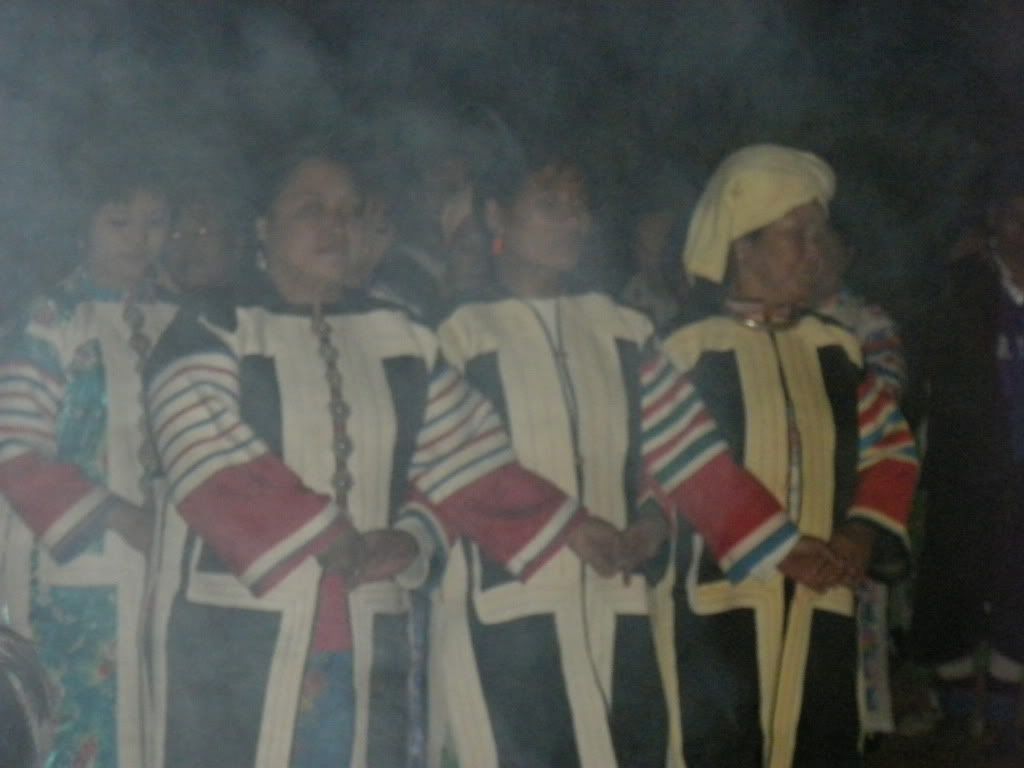
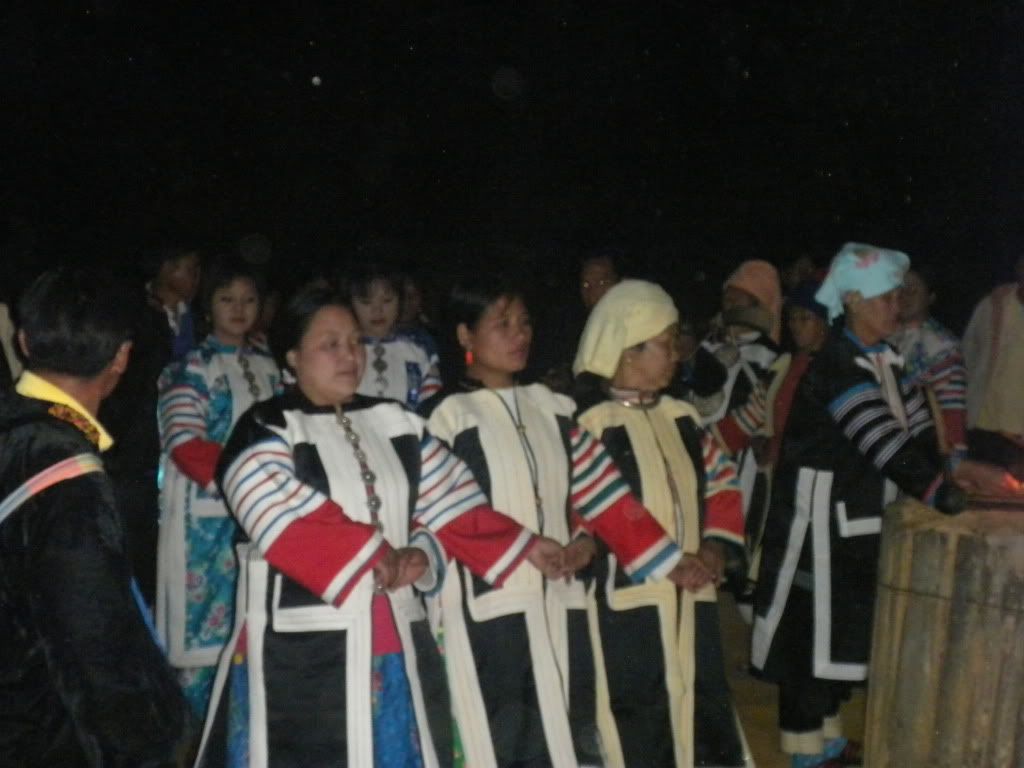
If you feel like reading some more about the Lahu, here’s the information from Sawadee.com on them:
“The Lahu originated in Tibet and southwest China and migrated to Thailand, through northern Burma, as well as to Laos and Burma and Vietnam. Since "Lahu", the name of their tribe, means "hunter", the Lahu obviously pride themselves on their skills in hunting and trapping. They are also famous for their knowledge of herbal medicine.
The Lahu are animists and ancestors worshippers. Some are Christians or Buddhists. About 30% of the Lahu have been converted to Christianity and have abandoned their way of life. Many have abandoned their traditional way of life as a result. Animist Lahu believe in one spirit with overall control all the others, and they are rather predatory in search of a marriage partner, but divorce and adultery are common.
Lahu villages are at high altitudes at about 1,000 meters. The Red Lahu are the only tribe to build a central Animist temple, surrounded by banners and streamers of white and yellow flags. If there is a source of water near the village, they build a series of bamboo pipes to bring water into the village. Houses are built on high stilts with walls of bamboo or wooden planks, thatched with grass. A ladder leads to an open central living area, with a store room to one side and living quarters to the other. There is one large bedroom, partitioned off as necessary according to family size. The main room has a central fireplace.
The Black Lahu are the most reserved, but wear the most distinctive costumes. Lahu women are skilled in weaving cloth, both on back-strap and foot-treadle looms, producing delicate patchwork trims, and unusual embroidery work. The Black Lahu women wear the most distinctive costumes within this tribe. They wear a black cloak with diagonal cream stripes. The top of the sleeve is decorated in bold colors of red and yellow. Red Lahu women wear black trousers with white edging and vivid sleeves of broad red and blue stripes. All the other Lahu tribes have supplemented their traditional costumes by sarong and Thai shirt. Men and women together make some of the finest baskets to be found anywhere in Thailand. Lahu men produce excellent crossbows, musical instruments, and other items made of wood, bamboo and rattan.”
Finding Toy was difficult once again, and with the temperature having dropped even more it had gotten quite uncomfortable for me. Eventually he showed up, emerging from his family’s house. Francesca and I exchanged e-mail addresses with our companions and huddled together in the back of the pick-up. Toy drove us to Nong Tong, and told us he’d see us the next morning at 10:00 AM.
Francesca and I woke up a little earlier than that on the 24th, thanks to the roosters. Breakfast was served by Susanan, who told us Albert had left for Chiang Mai. He hadn’t told us and we felt that was a bit strange. The fruit platter for breakfast made up for it though, and I feasted on the fruity deliciousness. Toy picked us up a little later and off we went to explore the villages around Soppong and Nong Tong.
Our first stop was Ja Bo, another Black Lahu village. The people here had also celebrated New Year’s the previous evening and life seemed to have halted. Here and there some kids were playing with fireworks, some women were walking around aimlessly, but the majority of people were inside, sleeping off the party. The village was situated between some high peaks and looked majestic. The houses themselves were a little less impressive. After a short walk through the village we stopped for a drink at the only little mart in town, and got a picture of the owner in her traditional outfit.
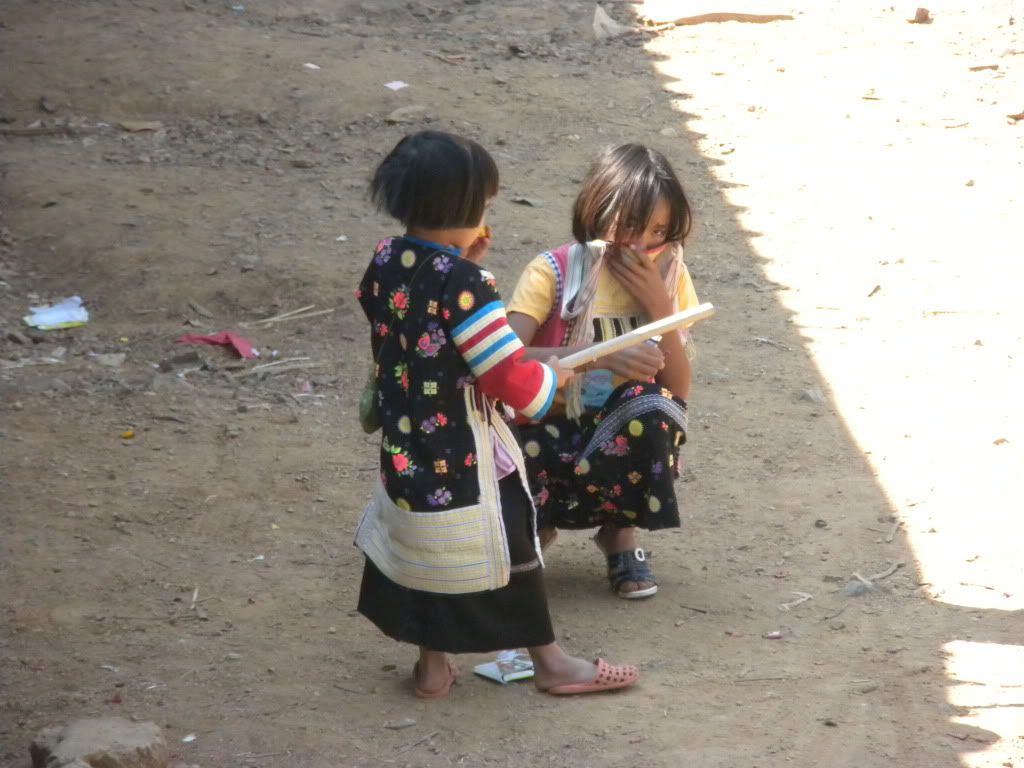

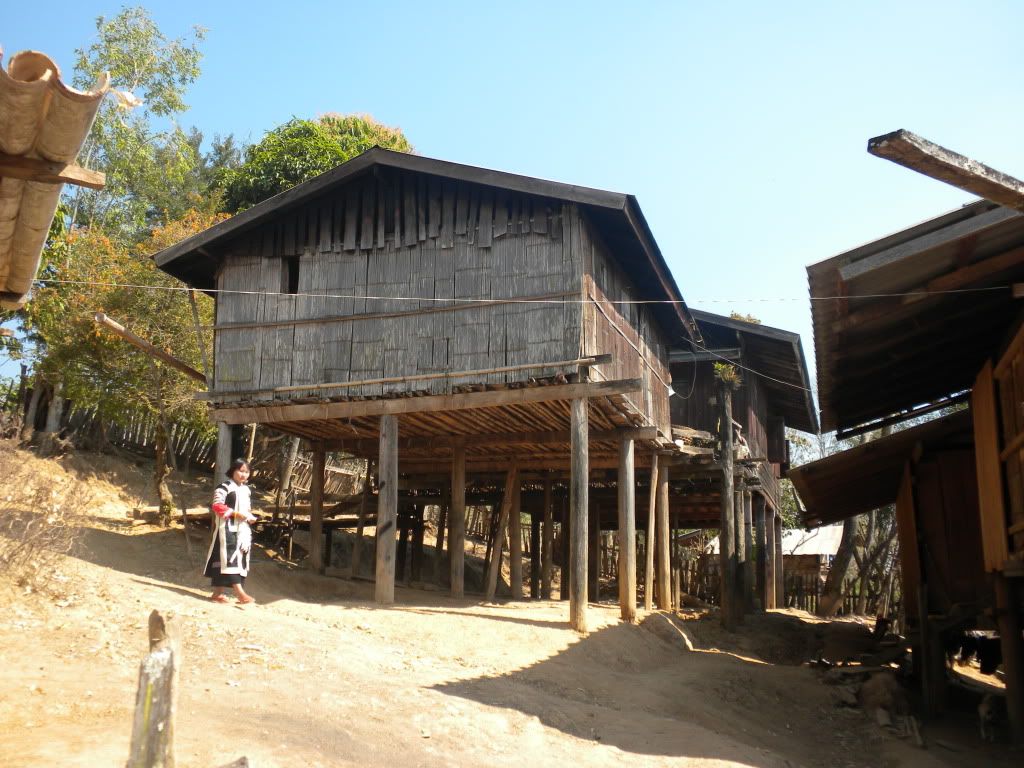
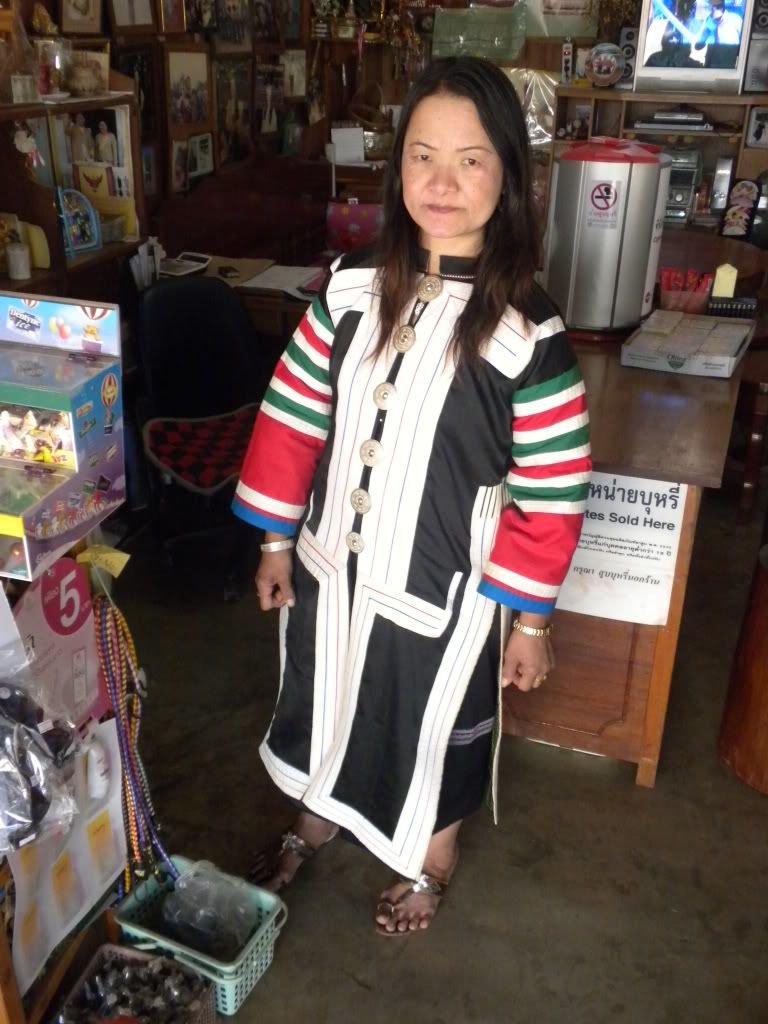
Next up were the Shan in Mae Lana, a nicely organized little village in a valley. The people here seemed to have advanced more than the Black Lahu. Most of them had shed their traditional clothing, opting for jeans and t-shirts instead. There was a school in the village, as well a temple. A river runs right through the village rice fields, as well as the community, giving name to the village: Mae Lana means ‘river running through paddy fields.’ Toy showed us some older ladies weaving away, telling us they still sew by hand, a custom slowly being replaced by sewing machines. Toy also showed us a home-made wooden cowbell. He then took us to the temple, which looked to be decaying a little from up close. We walked around for a while, noticing Toy had started sweating rather badly, looking sickly. Before returning to the car Toy showed us the river… which looked more like a small stream. The dry season was punishing the water supply. This also showed when we looked at the paddies, which looked completely barren.
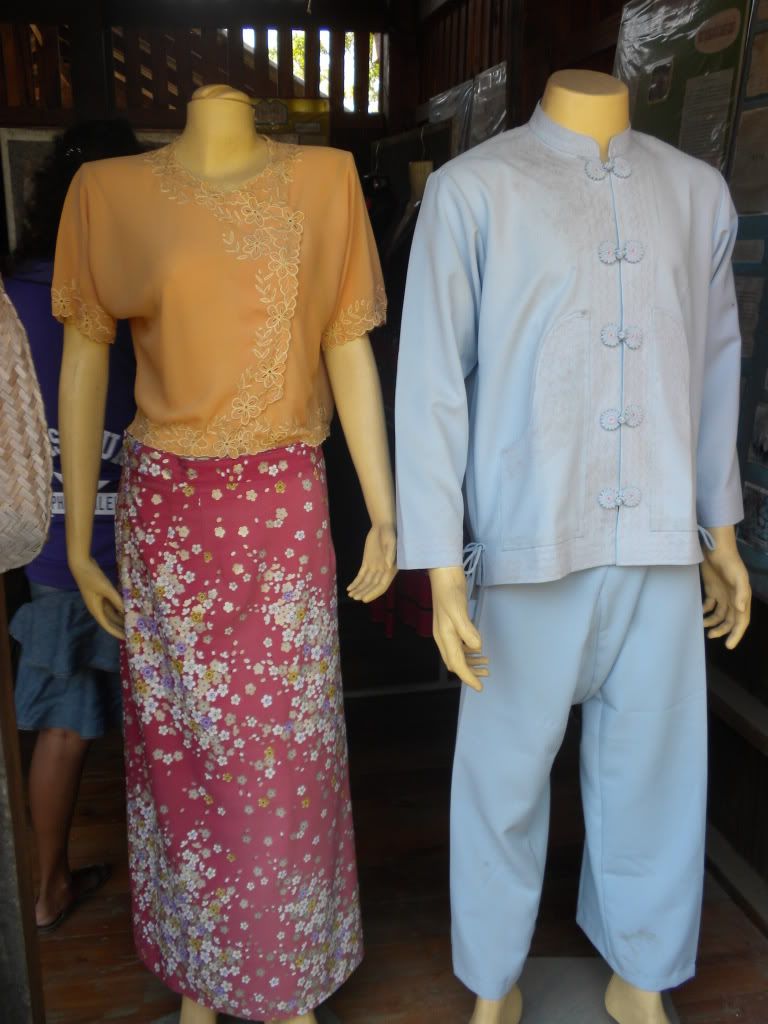
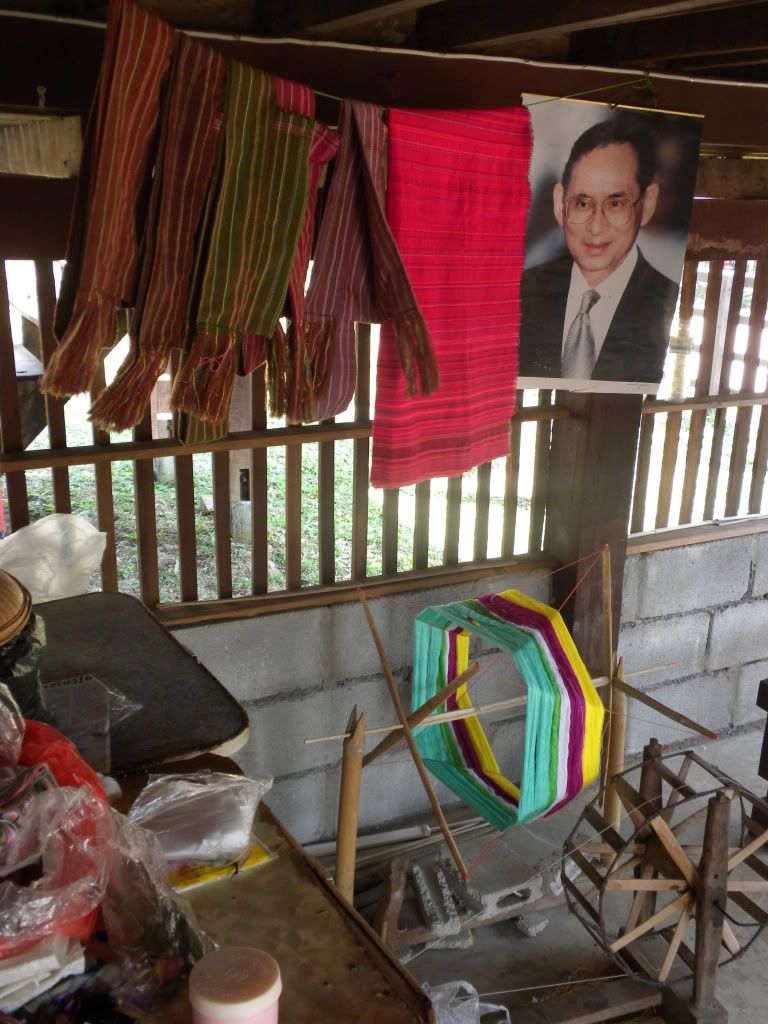

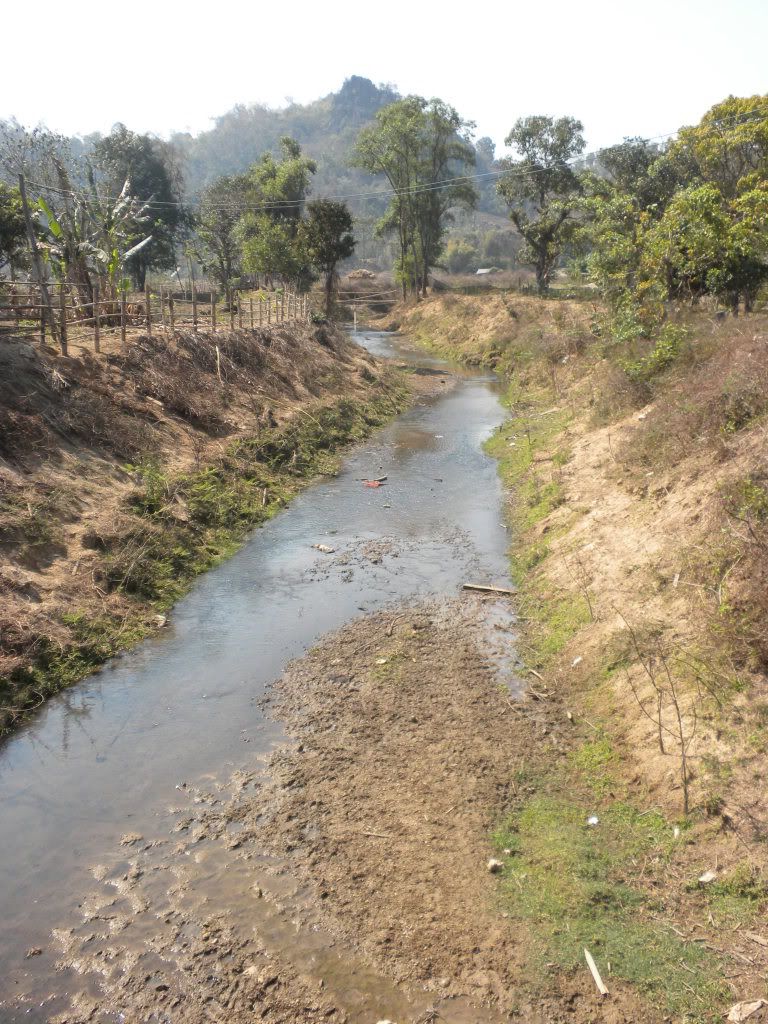
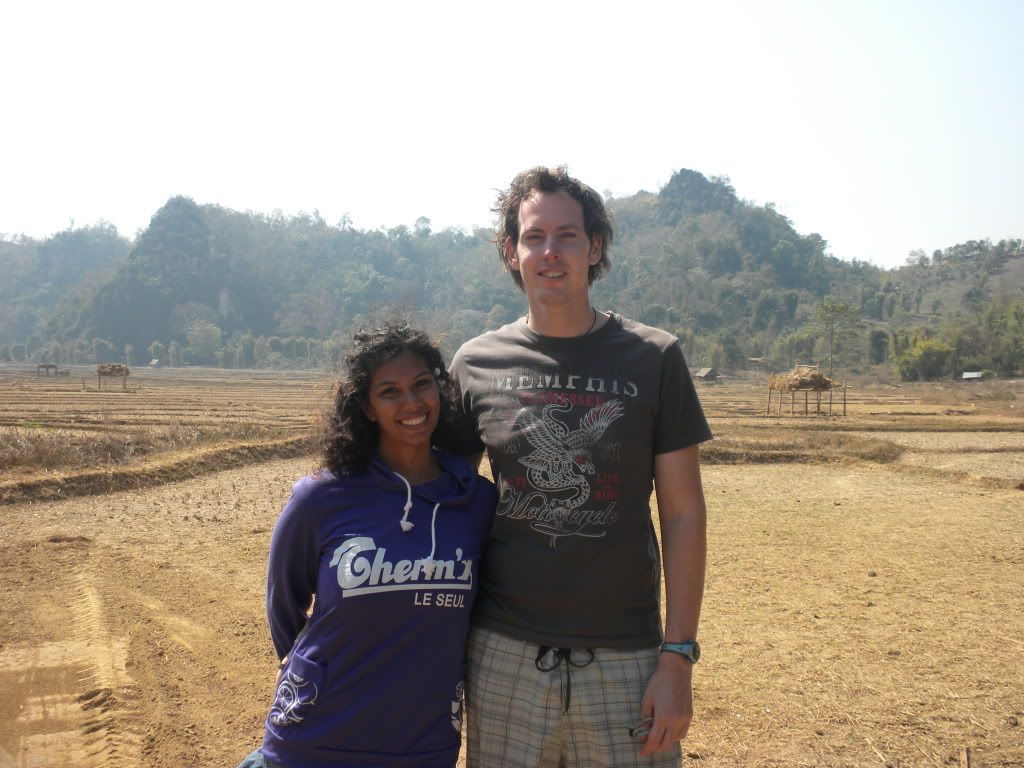
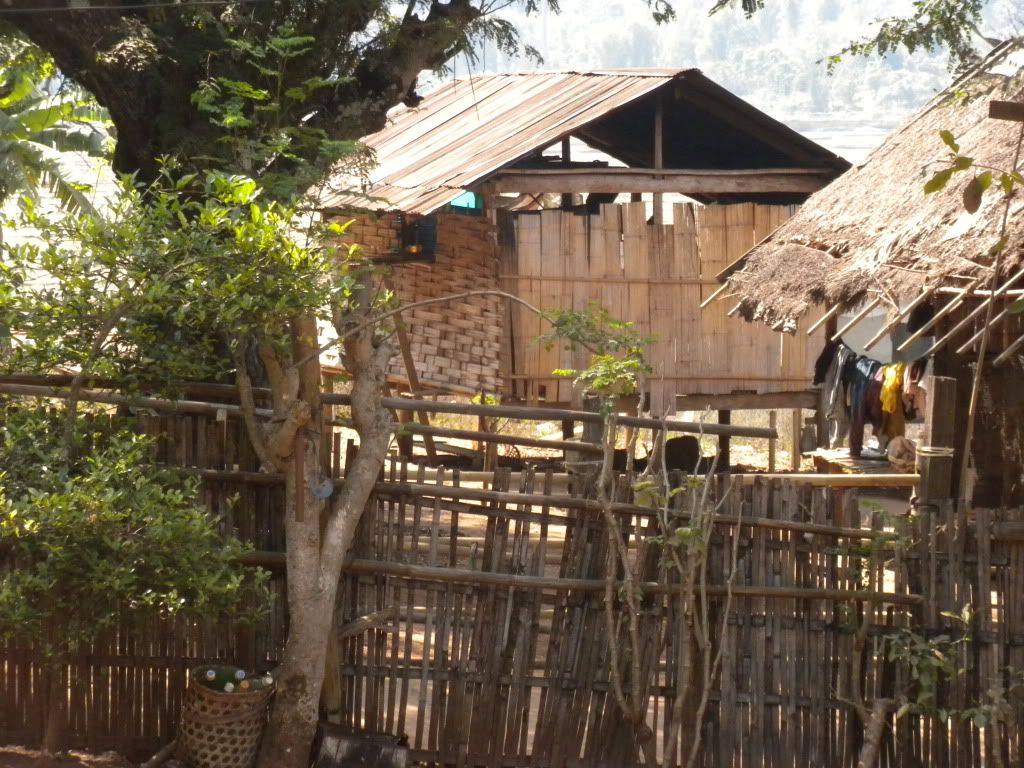
Toy started doing progressively worse, blaming last night’s food for his very upset stomach. The poor guy had to stop several times to take a breather outside. Francesca and I discussed driving for him, but the roads were so horrible and crooked that we didn’t dare try. With a delay we finally made it to Ya Pa Nae, a pretty remote Red Lahu village. The road leading up to the village had been an old dirt road, and Toy said foreigners hadn’t come here for a while. Two little kids followed us around, examining Francesca’s nails first, and then also her hair. We guessed curly hair was a rare sight for them! The center of the village had a New Year’s celebrations altar up. We saw a bunch of the dough-covered rice-balls and a whole pig’s head as part of the offerings. Little kids were playing on the streets with stones. Francesca remarked she couldn’t even remember the last time she had played with stones, if at all. Kids nowadays all need PSPs to get through the day.

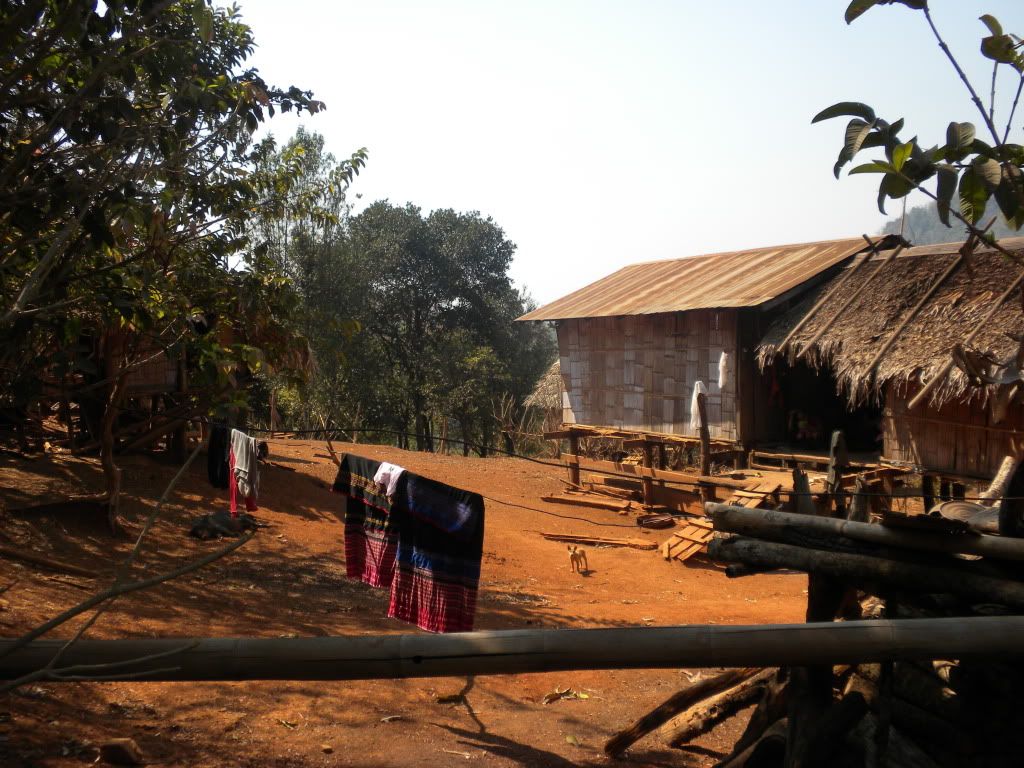
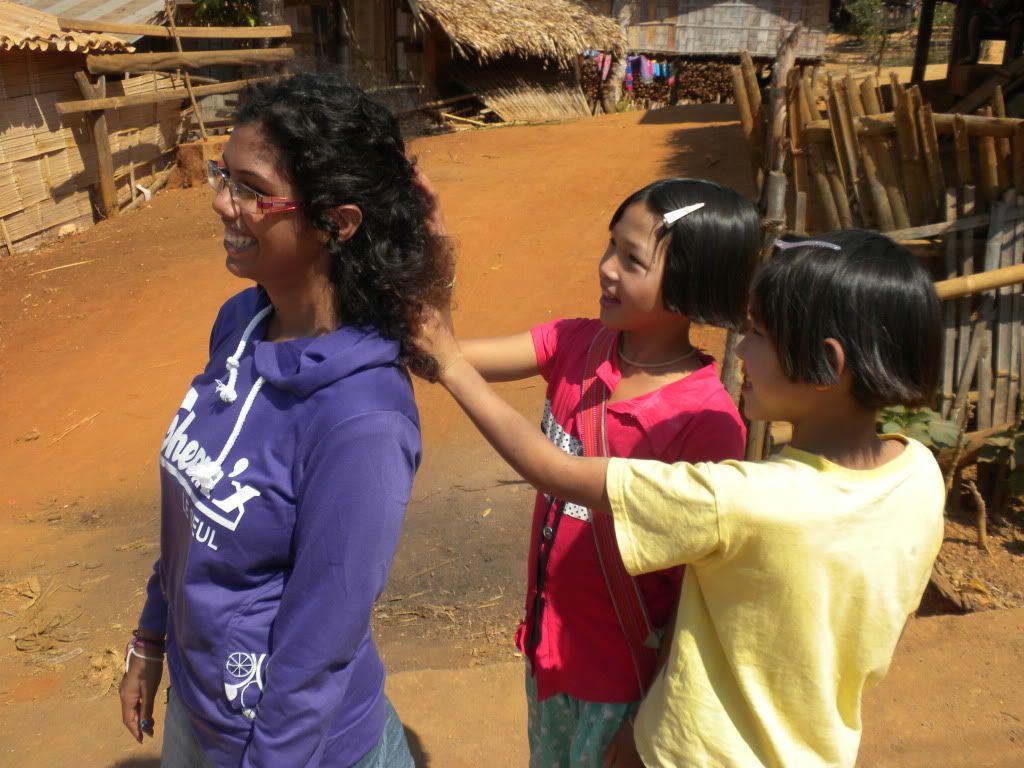

Getting to the last village was another choir for Toy, but here at least he knew someone so he could grab a pillow and lay down for a while. We had arrived in Ban Muang Pam, a Karen village. As Francesca and I walked around we noticed this village looked more developed as well. There was a rafting business, several shops and the houses generally looked nicer. The first thing we spotted was the village elementary school. The kids were running around in their uniforms, whilst we inspected their classrooms. The rooms looked basic enough, and there were quite a few children for each class. Even the toddlers had their own room, where they were sleeping quietly on some blankets. Here and there we saw some old women in their old costumes, and we managed to get a picture of the bright red outfit. A giant water buffalo right next to a house was the next attraction for us, after which we returned to Toy.
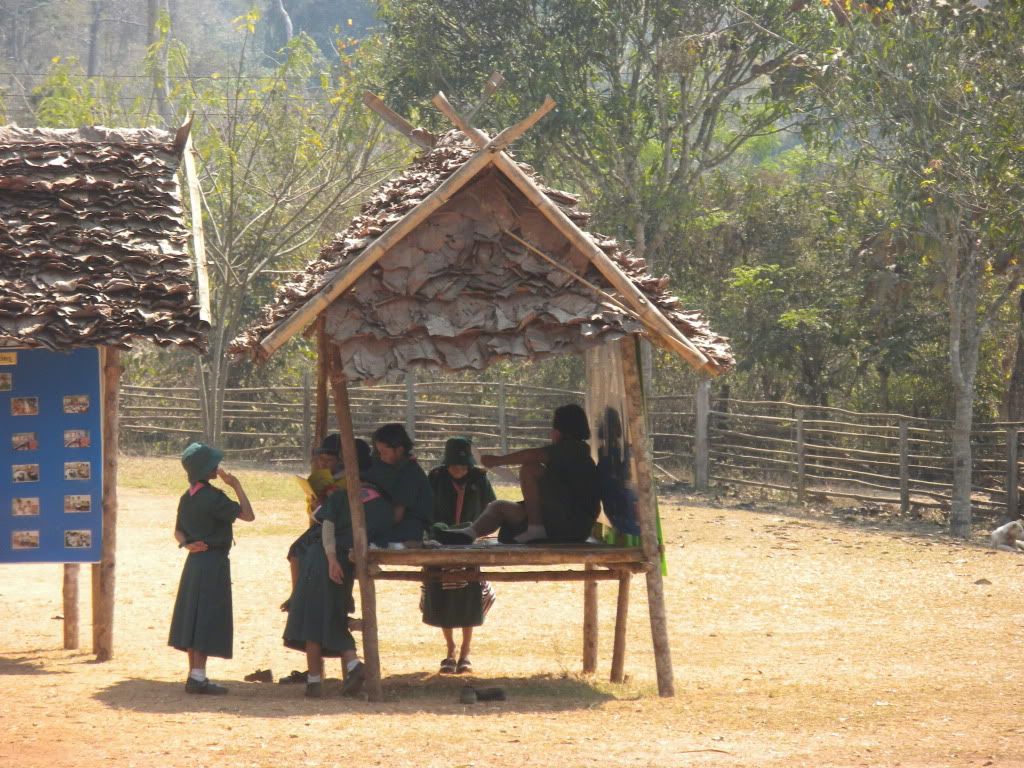
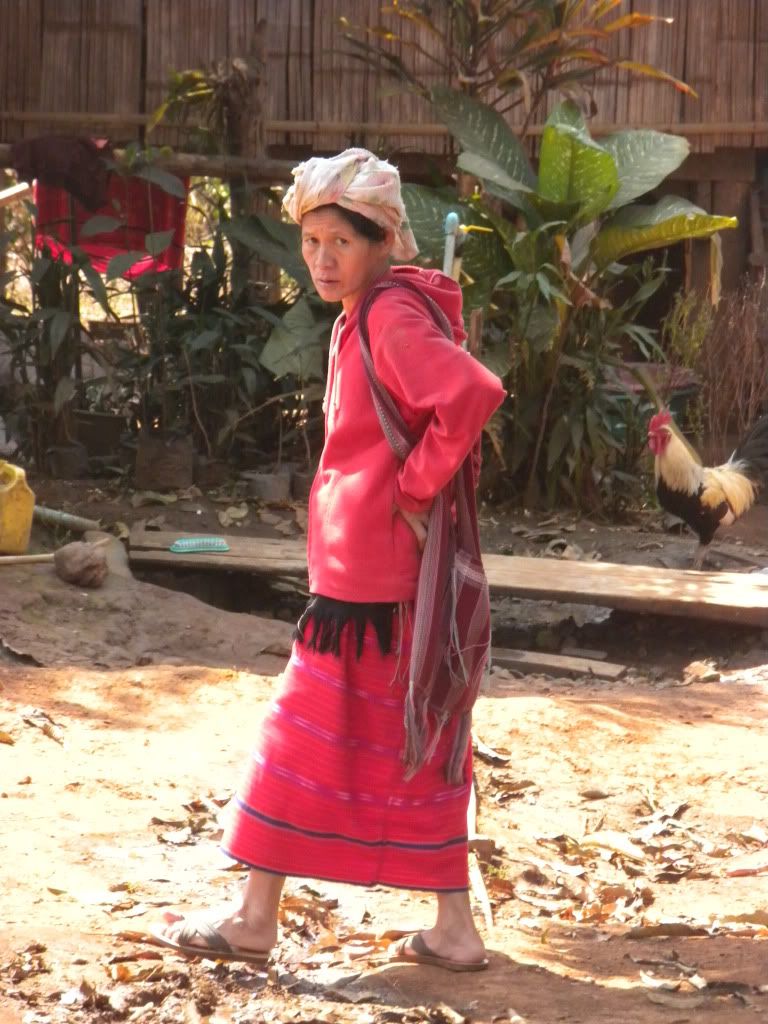
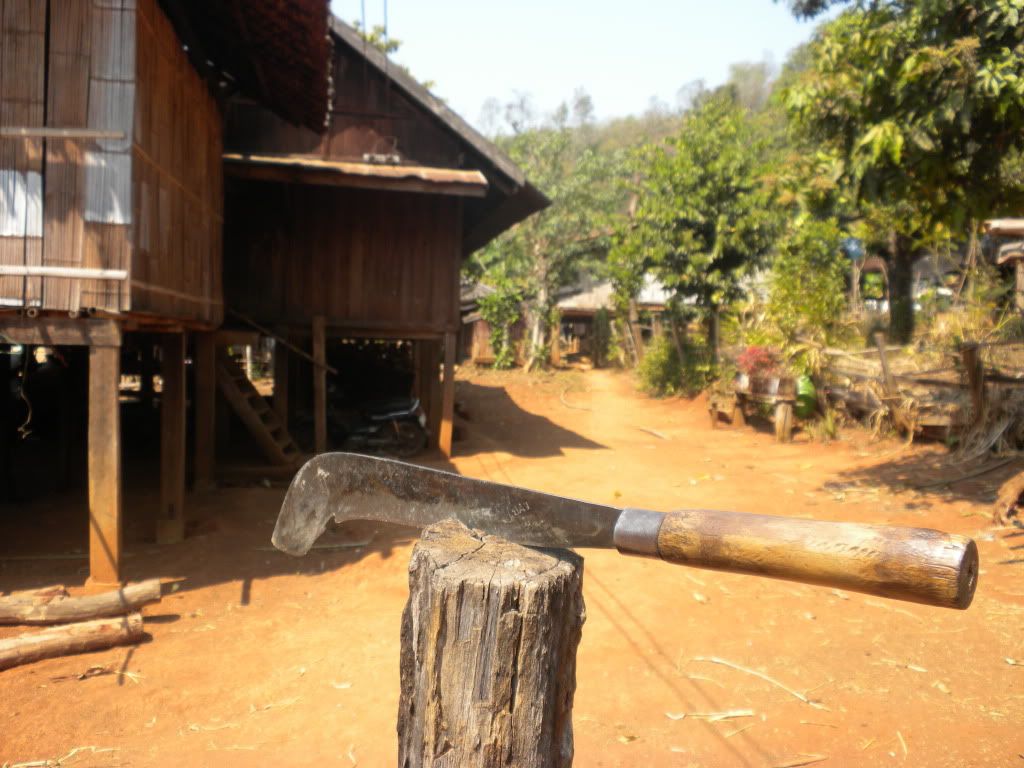
Toy then somehow managed to drive and sweat us to the final stop of the day: Nam Lod Cave. Francesca and I had read some crazy stories about the exploration of this cave. It had been found by John Spies, and he had started taking people there. A Dutchman had fallen down a waterfall deep inside the cave, dying on impact on a platform below. It took several days before they managed to recover the body. Spooky! Anyway, Toy gave us money to explore the caves by raft and retreated to get some sleep. We got a raft tour through 3 caves, including a return to the start of the cave. We hadn’t been on a bamboo raft before, so this was pretty exciting. We jumped on and were pushed off. A few minutes later we arrived at the starting point of the walk through the first cave.

Our guide showed us some really cool rock formations. We saw flowstone, which has been turned white and shiny by streaming water. We also saw a giant sinkhole, eroded by the acidic water in the cave. The guide showed us gigantic pillars, stalactites and stalagmites. One pillar in particular attracted Francesca’s attention: a popcorn pillar. We continued our gaslight-illuminated tour by crossing over the water and entering cave two. Cave two started with a steep climb and some nasty formations called brimstone dams. They’re small, dry pools formed by water, many in succession. Stepping in/over them is dangerous and we had to be careful not to break a leg. The guide shone her light on a crocodile-shaped pillar and made us laugh a little.
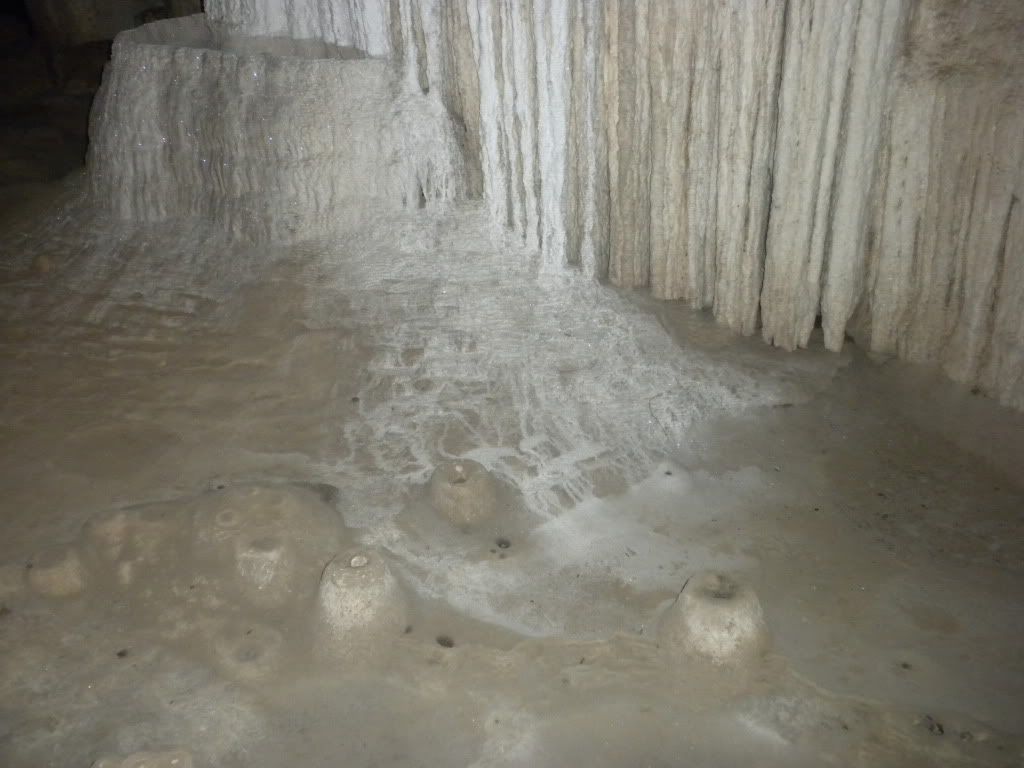


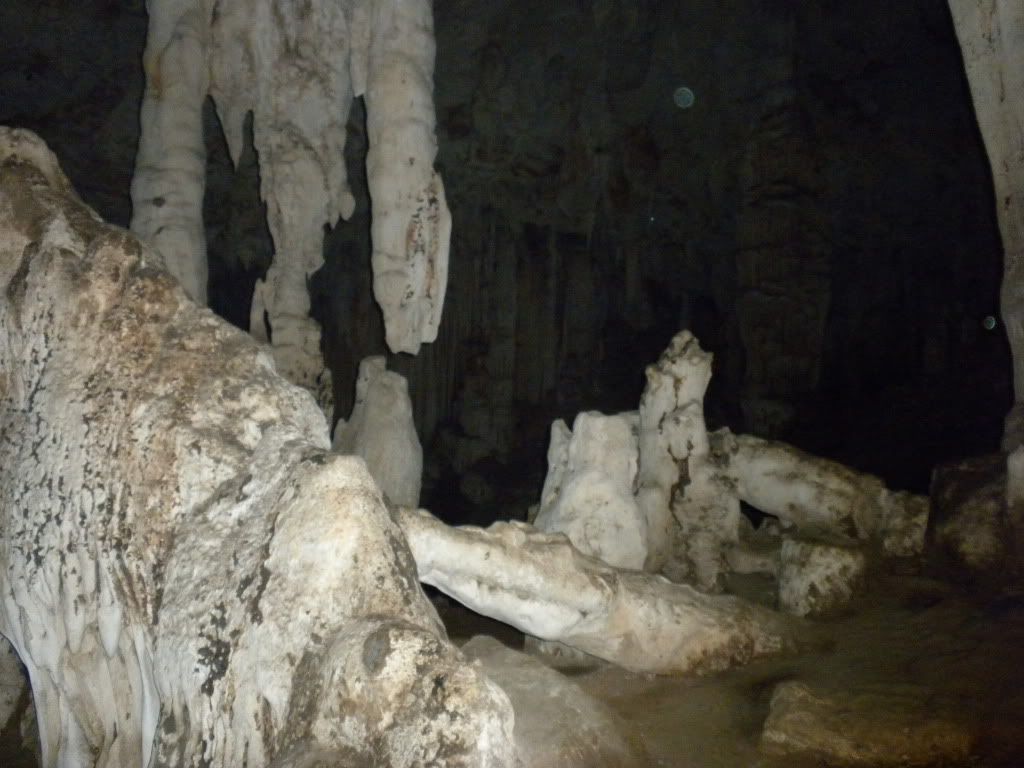
The coolest part of the cave came next: a pre-historic painting of a deer, an arrow and the sun, dating back 2 to 3000 years. Unfortunately, a young kid cleaning graffiti in the cave had tried to clean it, leaving only the outlines of the painting. The same pre-historic people had also used the caves for burials, and several coffins still stood around. Amazing to see! We went back down the scary steps and jumped back on our raft. On our way to the final and third cave we saw loads of fish surrounding us. We had bought some fish food and it didn’t take long until they were all fighting over our treats. We arrived at the exit on the other side of the cave, which showed us a grand opening archway. Here is where the birds come flying in in the evening, and the bats go out. A true spectacle according to some; unfortunately we’d have no time to witness such things. Instead, we climbed up the guano-covered staircases to look at the bat-covered rocks above us. We looked at some more coffins, even spotting a tiny Buddha statue hidden in an alcove. Finally we turned around, descended the poo-stained stairs once more and got back on our raft to see if Toy was still alive.
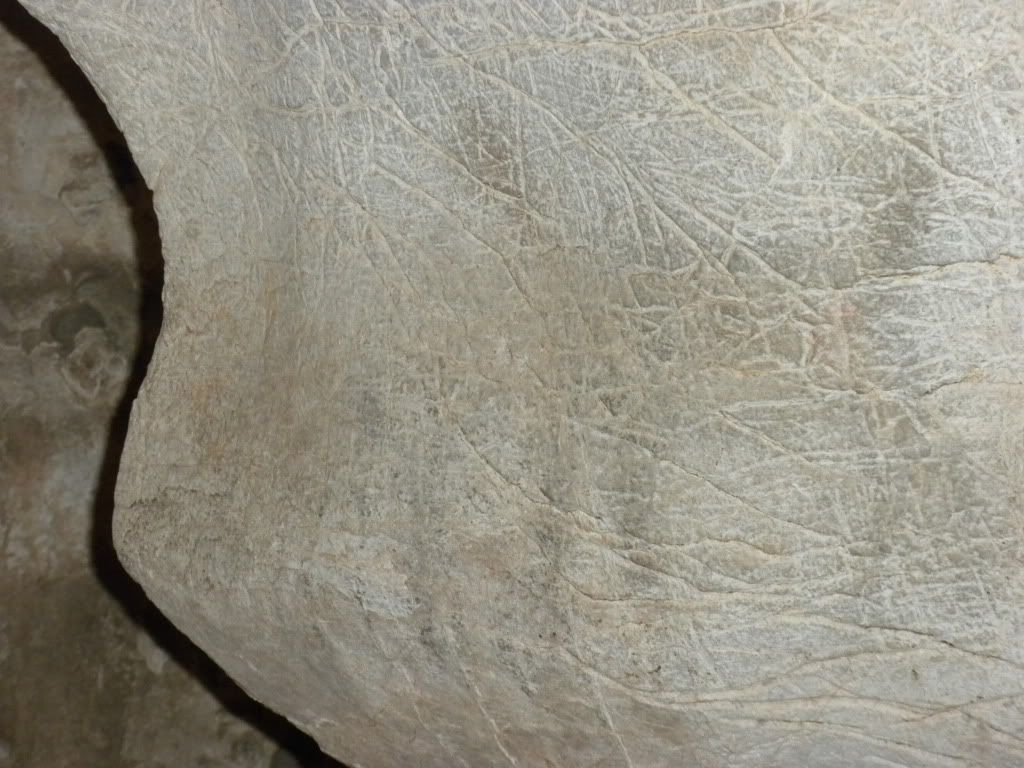

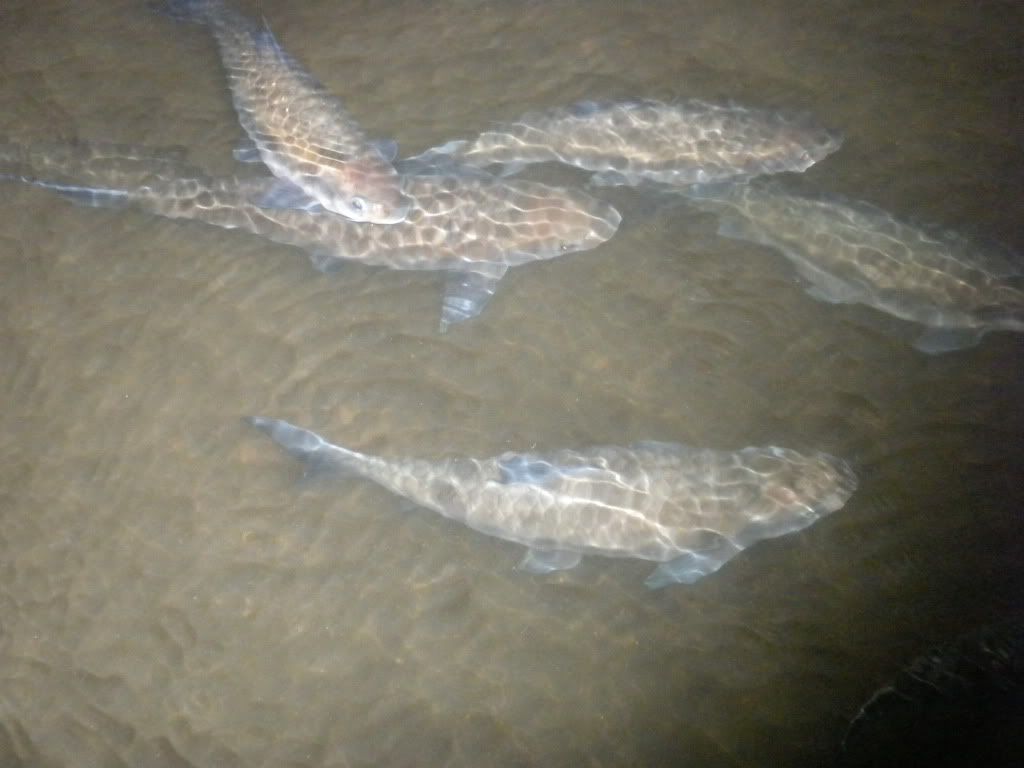
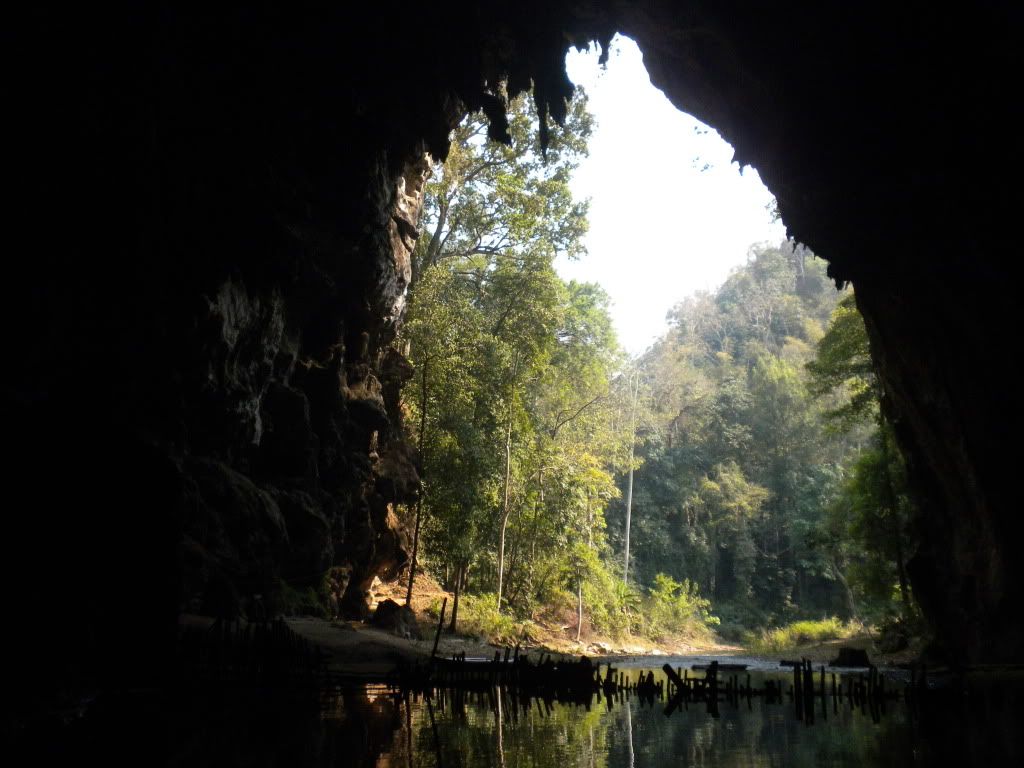

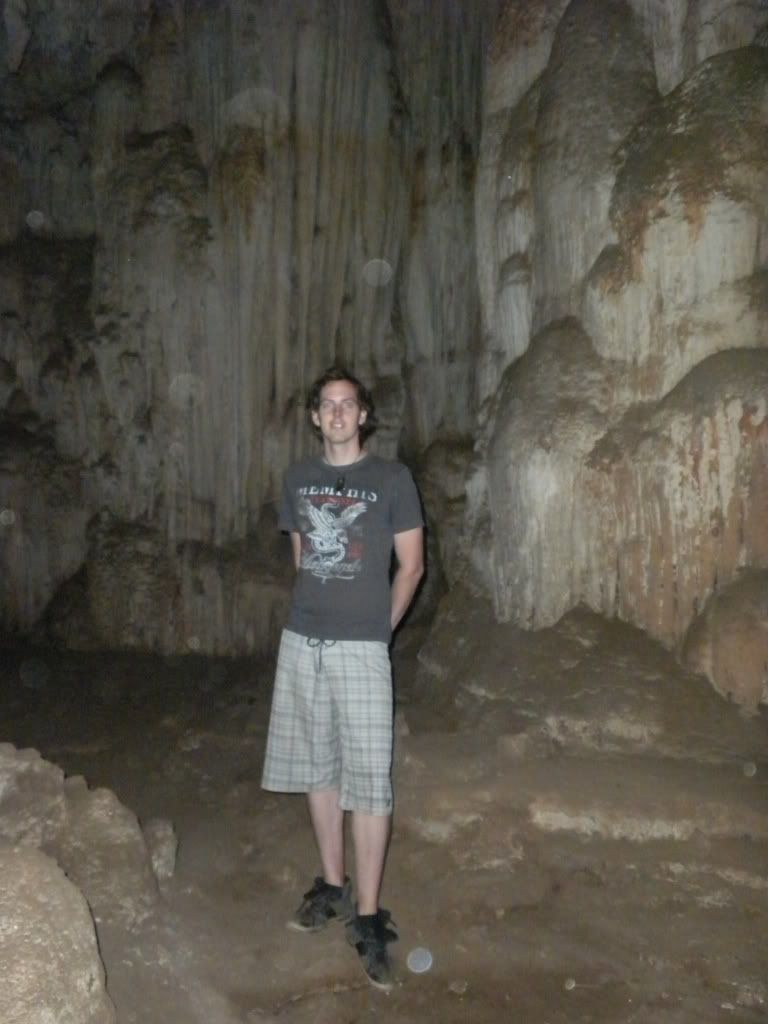

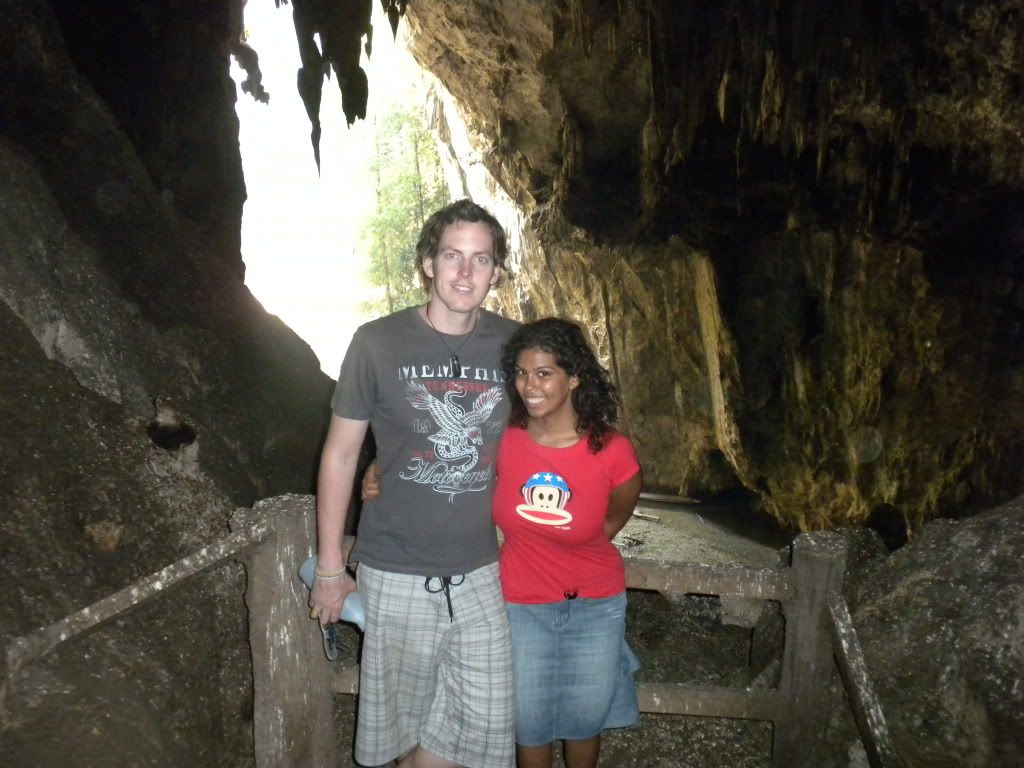
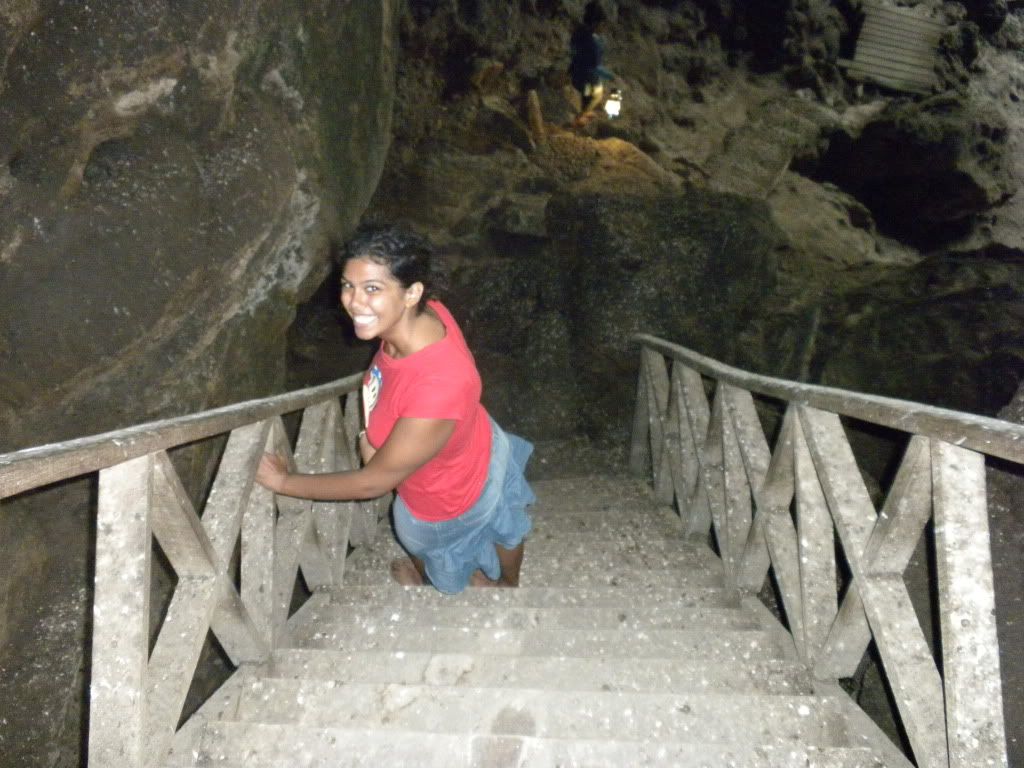
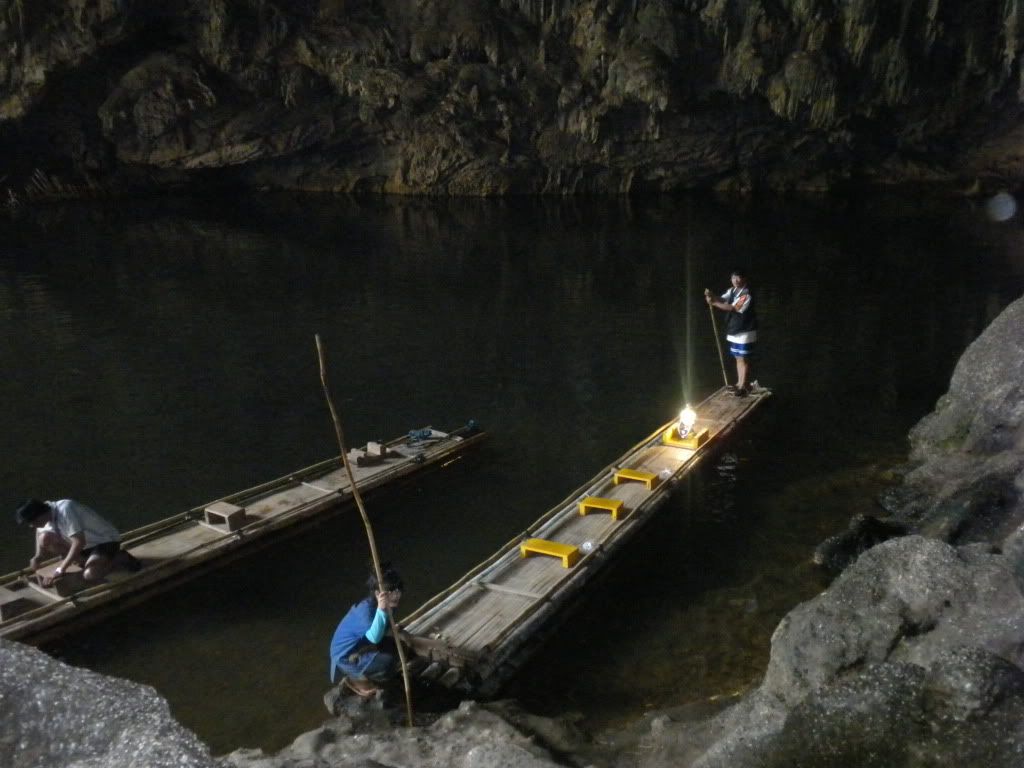
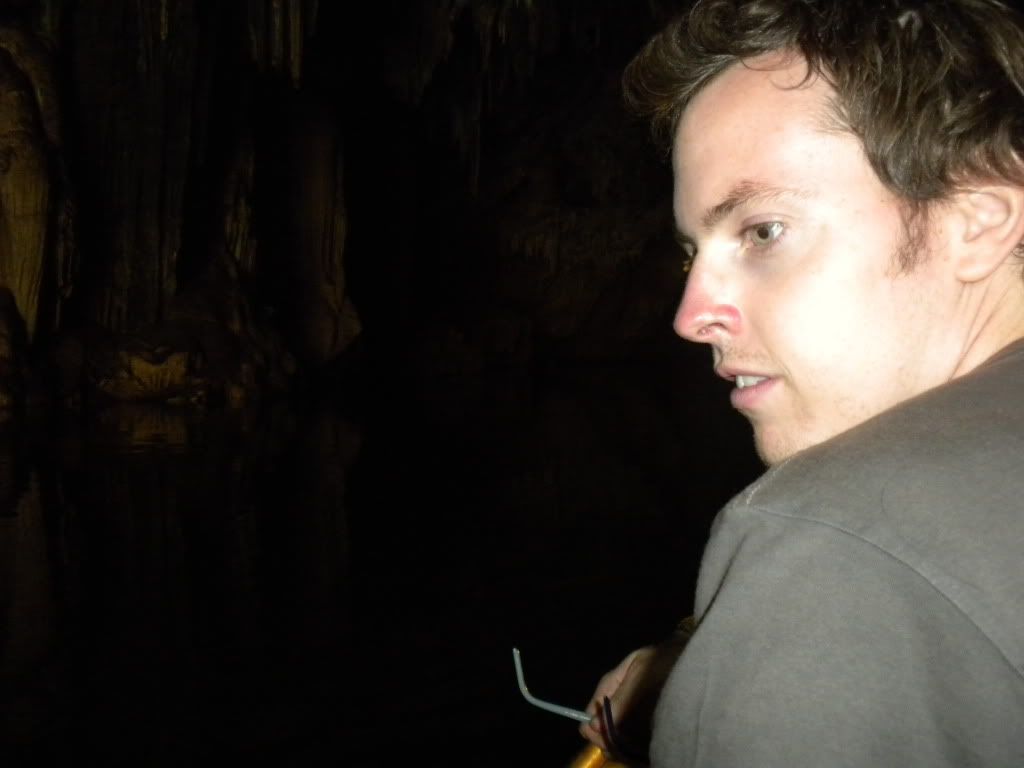
Toy was lying on his back and appeared to be breathing, so we woke him up for the final stint of our trip. We gave him some water, but he looked like he needed a few days of rest. He brought me to the bottom of the walk to Nong Tong, and dropped Francesca off at the village itself. I had the task of picking up an Elvis Sandwich for her, as she was hungry and had been craving some normal (read: unhealthy!) food. We spent the rest of the evening relaxing, finishing John Spies’ book. Francesca even made friends with a cat, which had found her back the perfect spot for a nap. We had our last dinner with Susanan and turned in early to get ready for the daunting day ahead.

On the 25th of February Francesca and I were to return to Chiang Mai. We had breakfast with Susanan’s daughter, who had taken over from her mother, because Susanan had left for Bangkok earlier that morning. Both our hosts had left before us. The lack of professionalism both endeared us, because it showed genuineness, and disappointed us, because we had at least expected an apology/explanation. Regardless, we packed up and said goodbye. We were unsure what time the bus to Pai would leave exactly, so I had decided to go a little early. Even the villagers seemed unsure about the arrival time of the public bus, and we ended up standing around for a good hour before the bus finally showed. We jumped in first (thank god we did) as the bus piled with locals. We got some decent seats, and actually enjoyed the following hour on our way to Pai.
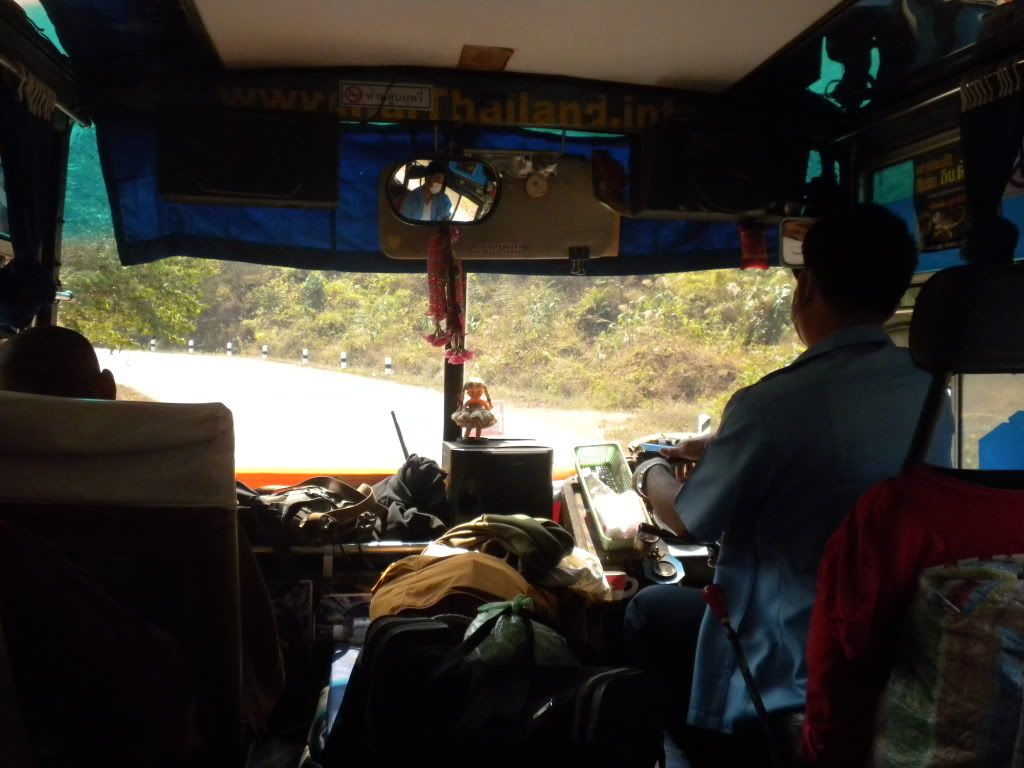
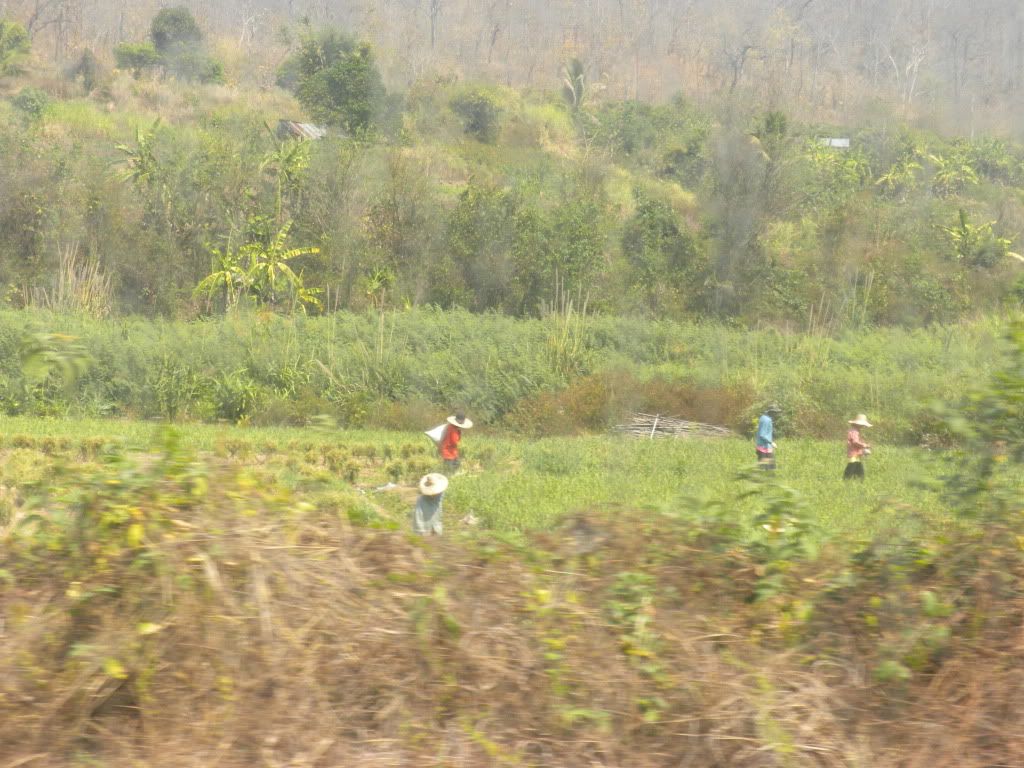
We arrived in Pai around 11:00 AM, giving us roughly 2 hours before our minivan to Chiang Mai would leave. We sat around at the ‘Baan Pai Village’ for a while and Francesca had spaghetti with garlic bread. I wasn’t feeling fantastic and opted to keep my stomach sober. The 2 hours went by quickly and we went to the minivan a little early. We learned that we’d have the van all to ourselves, giving us some legroom for the 3-hour return drive to Chiang Mai. It helped me a lot, as I could stretch out and kill some time with my eyes shut. Schumacher was our driver again, which made the trip fast, but the drive unbearable. Sleep was ultimately impossible, so I spent the remainder of the time reading, whilst Francesca watched ‘The Other Boleyn.’ We arrived in Chiang Mai around 4:30 PM, and were dropped off at the Yez Hostel. Francesca will tell you what horror story unfolded next...
